
Decoding the AP Language and Composition Exam Rubric

February 7, 2024
The AP Language and Composition Exam is a popular AP exam for students in AP Language classes as well as students who aren’t currently enrolled in AP English. Many of the skills tested on the exam are skills students practice in high school English classes: synthesizing information from multiple sources, analyzing an author’s rhetoric, and writing argumentative essays.
The first part of the exam is a multiple choice section with questions asking students to analyze nonfiction texts (23-25 questions) and make editing choices on short essays (20-22 questions). The multiple choice section accounts for 45% of the AP Language exam score, and students are given one hour to complete it.
The second part of the exam requires students to write three essays. The three essays are Synthesis, Rhetorical Analysis, and Argument, and students are given a total of two hours and fifteen minutes to complete this portion of the exam. The fifteen minutes is considered the “reading period” and is the approximate amount of time you should use to read the given sources. Most of your reading time should be dedicated to the Synthesis essay since there are six or seven sources to read through for this essay. The essays account for 55% of the Language exam score.
For each essay, students can earn up to six points. It can be difficult to decipher what is required to earn these points and how students might gain or lose them. Since the AP Language Exam is a standardized test, there are specific things readers are looking for to award points in each category, which are outlined in the rubric for the essay questions.
Thesis (0-1 point)
According to the AP Language rubric, your thesis must respond to the prompt with a thesis that presents a defensible position.
The thesis point is usually the easiest point to gain, but having a strong thesis will also set you up for success for the rest of the essay. You want to make sure your thesis is on topic and defensible, meaning there is sufficient evidence to back up your ideas, either in the given text (for Synthesis and Rhetorical Analysis) or in your examples (for Argument).
For the Synthesis essay, your thesis must take a strong position, not just restate the prompt or show pros and cons for two sides of the given issue. For the Rhetorical Analysis essay, your thesis must analyze the writer’s choices, not state your own opinion on the topic. For the Argument essay, again, you must take a strong position on the given topic.
As you write your essay, make sure all paragraphs and ideas are in defense of your thesis .
Evidence and Commentary (0-4 points)
According to the AP Language rubric, your evidence and commentary must provide specific evidence to support all claims in a line of reasoning and consistently explain how the evidence supports a line of reasoning.
A line of reasoning is the formal structure of your argument, which should be well organized to help prove your thesis – ideas should be grouped properly and build on each other as you work through the essay.
Evidence and commentary is the place where most students have room for growth. Your evidence should be relevant , significant , and well analyzed . Many students have evidence but don’t include enough analysis of their evidence. You want to make sure you’re showing how your evidence supports your ideas , assuming no piece of evidence is self-supporting.
For the Synthesis essay, you will use evidence from the given sources to support your position. Evidence should be cited and scrutinized, not just placed into the essay to stand on its own. The exam requires you to cite from at least three sources, though more can be useful and help show a higher level of sophistication, as long as all the evidence is examined as thoroughly as possible.
For the Rhetorical Analysis essay, you are examining rhetorical devices used by the author of the essay. These devices may include frequent repetition, personal anecdotes, extended metaphors, particular diction, detailed imagery, or concrete data (to name a few). Make sure you’re familiar with a number of rhetorical devices to prepare for this essay. You want to make sure you’re stating why these devices support the author’s main idea.
For the Argument essay, you are bringing your own evidence to the table. Your examples can come from your reading (like novels or essays), your studies (like history or social studies), or your personal experiences. No particular type of evidence is superior to another as long as it is fully relevant and thoroughly explained. This essay gives you the broadest range of material to work with, so you may want to consider some topics you’re comfortable writing about before the exam and use them as long as they are on topic.
Sophistication (0-1 point)
According to the AP Language rubric, essays that gain this point must demonstrate sophistication of thought and/or a complex understanding of the rhetorical situation.
The sophistication point is typically the most difficult point to gain on an essay. It is sometimes referred to as a “unicorn point,” and only about 5-15% of students usually get this point on any given essay. While challenging to earn, there are some things you can do to work towards earning this point.
There are two ways to gain this point: you can demonstrate an advanced writing style or a nuanced argument .
To achieve an advanced writing style, you’ll want to use strong vocabulary, adhere to the rules of standard written English, and vary sentence structure. While these elements don’t have to be perfect, the stronger they are, the more likely you’ll be to earn this additional point. Make sure any complex sentences are clear; being wordy without purpose will work against earning this additional point.
To achieve a nuanced argument, you’ll want to avoid sweeping generalizations. The more specific the wording or example, the better. You’ll also want to directly address potential counterarguments and argue against them, putting the topic in a broader context and examining nuances in the given situation. The AP Language rubric is also looking for writing that is consistently vivid and persuasive. Include details and imagery; use strong and convincing language.
While this will remain the hardest point to achieve for any given essay, practice will help. One of the most effective ways to ensure your practice is properly focused and impactful on your performance is to work 1-1 with an expert tutor, who can give you personalized feedback on your FRQ responses. Get in touch with one of our Program Directors today or call 1-800-MY-TUTOR to get started.
*Any information in italics is directly from the AP Language rubric.
Cancel reply
Your email address will not be published. Required fields are marked *
Related Posts

Grade Inflation: What Families Need to Know
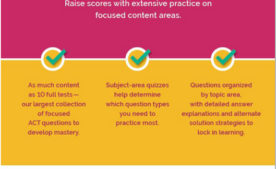
Summit’s 1-1 Peak Academic Math and Writing Courses
Finals Will Be Here Sooner than You Think

Mid-Semester Math Check-in: Assess Your Progress and Improve Your Study Habits

Some Advice for Students When They Don’t Click with Their Teacher
Executive Function Tips for Back-to-School

Hitting the Ground Running with AP Courses is Key

Summit’s 1-1 Peak Academic Math and Writing Courses

What is Active Reading? Strategies for Middle and High School Students

Grade Inflation. What it is and why Parents Should Care About it.

Who Should Test Early?

Introducing 1-1 College Tutoring

Approaches to Recovering from Learning Loss

Why your Student’s Grades and Courses Matter Earlier than you Might Think
One-on-One Customized Writing and Math Courses

Prospective Student-Athletes and the College Admission Tests

Summit Foundations of SAT and ACT Program

How Academic Tutors Help Students

Nurturing Greater Confidence in Math through 1:1 Discovery Learning

Improving Math Grades

Helping Students Master Critical Reading Skills

Successful Study Skills for Remote Learning During COVID
Making the Most of Live, Online Classes
Find what you need to study
2024 AP English Language and Composition Exam Guide
12 min read • august 18, 2023
Your guide to the 2024 AP English Language and Composition exam
We know that studying for your AP exams can be stressful, but Fiveable has your back! We created a study plan to help you crush your AP English Language and Composition exam. This guide will continue to update with information about the 2024 exams, as well as helpful resources to help you do your best on test day. Unlock Cram Mode for access to our cram events—students who have successfully passed their AP exams will answer your questions and guide your last-minute studying LIVE! And don't miss out on unlimited access to our database of thousands of practice questions. FYI, something cool is coming your way Fall 2023! 👀
Format of the 2024 AP English Language and Composition exam
This year, all AP exams will cover all units and essay types. The 2024 AP English Language and Composition exam format will be:
Section I: Multiple Choice - 45% of your score
45 questions in 1 hour
Section II: Free Response Section - 55% of your score
2 hours and 15 minutes for:
1 synthesis essay
1 rhetorical analysis essay
1 argument essay
Scoring Rubric for the 2024 AP Lang Essays
Synthesis Essay
1 point for a defensible thesis that responds to the prompt
Evidence and Commentary
Max of 4 points for providing evidence from at least 3 sources that support the line of reasoning AND commentary that explains and analyzes the evidence
Sophistication
1 point any of the following:
Creating a nuanced argument
Showing the limitations of the argument
Making effective rhetorical choices
Employing a style that is vivid and persuasive
Rhetorical Analysis Essay
1 point for a defensible thesis that analyzes rhetorical choices
Max of 4 points for providing specific evidence AND consistently explaining how the evidence relates to the line of reasoning AND showing how the rhetorical choices contribute to the author's message .
1 point for any of the following:
Explaining the significance of the rhetorical choices ( rhetorical situation )
Explaining the complexities of the passage and their purpose
Argument Essay
1 point for a defensible thesis
Max of 4 points for providing specific evidence AND consistently explaining the relevance of that evidence .
Crafting a nuanced argument by identifying complexities
Explaining the limitations of the argument by placing it in a broader context
Making rhetorical choices to improve the argument
Check out our study plan below to find resources and tools to prepare for your AP English Language and Composition exam.
When is the 2024 AP English Language and Composition Exam and How Do I Take It?
How should i prepare for the ap lang exam.
First, take stock of your progress in the course so far. What areas have you excelled and which sections need more focus? Download the AP English Language Cheatsheet PDF - a single sheet that covers everything you need to know at a high level. Take note of your strengths and weaknesses!
Build your study plan to review every unit and question type, but focus most on the areas that need the most improvement and practice. We’ve put together this plan to help you study between now and May. This will cover all of the units and essay types to prepare you for your exam
Practice essays are your best friends! The more essays you write, the more automatic the process will come, and the easier the AP exam will be!
Try some of the past exam questions here
We've put together the study plan found below to help you study between now and May. This will cover all of the units and essay types to prepare you for your exam. Pay special attention to the units that you need the most improvement in.
Study, practice, and review for test day with other students during our live cram sessions via Cram Mode . Cram live streams will teach, review, and practice important topics from AP courses, college admission tests, and college admission topics. These streams are hosted by experienced students who know what you need to succeed.
Pre-Work: Set Up Your Study Environment
Before you begin studying, take some time to get organized.
🖥 Create a study space.
Make sure you have a designated place at home to study. Somewhere you can keep all of your materials, where you can focus on learning, and where you are comfortable. Spend some time prepping the space with everything you need and you can even let others in the family know that this is your study space.
📚 Organize your study materials.
Get your notebook, textbook, prep books, or whatever other physical materials you have. Also, create a space for you to keep track of review. Start a new section in your notebook to take notes or start a Google Doc to keep track of your notes. Get yourself set up!
📅 Plan designated times for studying.
The hardest part about studying from home is sticking to a routine. Decide on one hour every day that you can dedicate to studying. This can be any time of the day, whatever works best for you. Set a timer on your phone for that time and really try to stick to it. The routine will help you stay on track.
🏆 Decide on an accountability plan.
How will you hold yourself accountable to this study plan? You may or may not have a teacher or rules set up to help you stay on track, so you need to set some for yourself. First, set your goal. This could be studying for x number of hours or getting through a unit. Then, create a reward for yourself. If you reach your goal, then x. This will help stay focused!
🤝 Get support from your peers.
There are thousands of students all over the world who are preparing for their AP exams just like you! Join Rooms 🤝 to chat, ask questions, and meet other students who are also studying for the spring exams. You can even build study groups and review material together!
2024 AP Lang Study Guide
🚧 unit 1 foundations of rhetoric: analysis of the rhetorical situation and claims ., big takeaways:.
Unit 1 is an introductory unit that lays the foundations for the reading skills associated with how to understand and analyze complex texts. Skills here include identifying the ASPECTS of a text, analyzing the claim given and the evidence used to support that claim, and determining the function of the “chunks” in the argument. Because the content in this unit is very foundational, it is looped throughout the rest of the course instruction.
Definitely do this:
📚 Read these study guides:
Unit 1 Overview: Claims , Reasoning , and Evidence
1.1 Identifying the purpose and intended audience of a text
1.2 Examining how evidence supports a claim
1.3 Developing paragraphs as part of an effective argument
🎥 Watch these videos:
College Board’s Instructional Video: Overview of The Rhetorical Situation .
Fiveable’s How to Read Like an AP Student .
Rhetorical Analysis Thesis Statements
Rhetorical Analysis Body Paragraphs
✍️ Practice:
Use the Fiveable ASPECTS Guidesheet to help you break down a complex text.
🗺 Can you identify these rhetorical devices?
You won’t be asked to name drop on the exam, but it can be helpful to use devices when discussing strategies. Try this Quizlet to help prepare.
Unit 2 Foundations of Argument: Analysis of an author’s choices in appeals and evidence
Unit 2 is an introductory unit that builds onto the foundations of rhetorical ASPECTS and moves toward planning and writing your own arguments. This unit focuses on the relationships between subject, speaker, and message, including examination of the structure and purpose of the given argument. The unit then moves into the developing thesis statements and building your own arguments with a clear line of reasoning .
Unit 2 Overview: Organizing Information for a Specific Audience
2.1 Analyzing audience and its relationship to the purpose of an argument
2.2 Building an argument with relevant and strategic evidence
2.3 Developing thesis statements
2.4 Developing structure and integrating evidence to reflect a line of reasoning
College Board’s Instructional Video: Identify Rhetorical Situation in a Pre 20th Century Text .
Fiveable’s video on How to Find Rhetorical Devices
📰 Check out these articles:
Here’s a list of recommended rhetorical devices with definitions and examples!
Use the Fiveable Rhetorical Precis Guidesheet to help you break down a complex text.
🗺 Can you identify these elements of practical argument?
You won’t be asked to name drop of the exam, but it can be helpful to use devices when discussing strategies. Try this Quizlet to help prepare.
👥 Unit 3 Confluence: Synthesis of multiple sources in argumentation
Unit 3 approaches multiple perspectives in argument through the lens of synthesis (that’s FRQ 1). In this study, you learn to identify effective and faulty reasoning while integrating a variety of evidence from credible resources that is properly cited in an original text.
Unit 3 Overview: Perspectives and How Arguments Relate
3.1 Interpreting character description and perspective
3.2 Identifying and avoiding flawed lines of reasoning
3.3 Introducing and integrating sources and evidence
3.4 Using sufficient evidence for an argument
3.5 Attributing and citing references
3.6 Developing parts of a text with cause-effect and narrative methods
Fiveable’s Introduction into Synthesis Essays and How to Begin Your Argument
College Board’s Instructional Video: Complexity in Argument .
🗺 Can you identify these elements of synthesis?
👀 Unit 4 Reasoning : Analysis of argument from introduction to conclusion
Unit 4 includes a greater depth of focus on the writing of effective arguments -- the line of reasoning created in the introduction, built with modes of discourse, and strengthened in the conclusion. An important note about these skills of argumentation is that they build toward all parts of every FRQ.
Unit 4 Overview: How writers develop arguments, intros, and conclusion
4.1 Developing and connecting thesis statements and lines of reasoning
4.2 Developing introductions and conclusions
4.3 Adjusting an argument to address new evidence
College Board’s Instructional Video: Understanding a Line of Reasoning .
Fiveable’s Effective Annotations .
Try Fiveable’s Guide to LOR Body Paragraphs .
🗺 Can you identify the rhetorical modes?
You won’t be asked to name drop them on the exam, but it can be helpful to use devices when discussing strategies. Try this Quizlet to help prepare.
🧐 Unit 5 Commentary and Analysis: Analysis of complex argument and intentional rhetoric
In Unit 5, the skills look at the minutiae involved in argumentation: development of the line of reasoning that produces strong commentary and maintains the primary claim through all parts of the writing. To achieve these goals, this unit includes a focus on transitions , modifiers , and qualifications for argumentative perspective .
Unit 5 Overview
5.1 Maintaining ideas throughout an argument
5.2 Developing commentary throughout paragraphs
5.3 Using modifiers to qualify an argument and convey perspective
5.4 Using transitions
Fiveable’s video on How to Improve Analysis Part 1 and Part 2
As well as how to Embed Quotes into Body Paragraphs
Rhetorical Analysis Body Paragraphs
Synthesis Essay Body Paragraphs
Argument Essay Body Paragraphs
Tara Seale’s adaptation for Creating a Line of Reasoning .
🏃♂️ Unit 6 Rhetorical Risks: Analysis of multiple perspectives , bias , and shifts with new evidence
In Unit 6, you will notice a direct link building on the ideas of Unit 3 as this instruction looks at position and perspectives while synthesizing information strategically to support a claim. For greater depth, this unit moves to modify a current argument to include new evidence .
Unit 6 Overview: Position, Perspective , and Bias
6.1 Incorporating multiple perspectives strategically into an argument
6.2 Recognizing and accounting for bias
6.3 Adjusting an argument to new evidence
6.4 Analyzing tone and shifts in tone
College Board’s Instructional Video: Creating a Nuanced Argument .
Fiveable’s video on Tracking an Author’s Argument
🚀 Unit 7 Complex Argumentation: Analysis of effective arguments, including concession and refutation
The skills of Unit 7 are about putting all units of study together to look at the complexity of a given argument and the effectiveness of the pieces built into that argument. Though many teachers will have addressed counterarguments, concessions, and refutations before reaching this unit, those skills are highly scrutinized in this segment of learning.
Unit 7 Overview: Successful and Unsuccessful Arguments
7.1 Examining complexities in issues
7.2 Considering how words, phrases, and clauses can modify and limit an argument
7.3 Examining how counterargument or alternative perspectives affect an argument
7.4 Exploring how sentence development affects an argument
Fiveable’s video on Arguments and Counterarguments
College Board’s Instructional Video: How Argument Demonstrates Understanding .
Check your progress with Fiveable’s AP Language Skills Matrix .
📝 Unit 8 Style: Analysis of how style influences the audience movement
Unit 8 covers how to understand the influence style has on the audience , and the purpose behind each decision. By analyzing these various tactics, students are able to understand the author’s audience , and how to effectively persuade them. Style is an important part in connecting the rest of the course and understanding how the rhetorical choices and devices are used to accomplish a purpose .
Unit 8 Overview: Stylistic Choices
8.1 Choosing comparisons based on an audience
8.2 Considering how sentence development and word choice affect how the writer is perceived by an audience
8.3 Considering how all choices made in an argument affect the audience
8.4 Considering how style affects an argument
Fiveable’s Analysis of the Mindset of the Audience
College Board’s Instructional video: Analyzing and Understanding the Audience
College Board’s explanation of Elements and Context for Style
Review this quizlet on Elements of Style for more practice.
✏️ Unit 9 Craft: Creation of your own complex argument with synthesis and rhetoric
The final unit of AP Language and Composition covers how to effectively form your own arguments by acknowledging and understanding complexities to create a nuanced and sophisticated argument. It focuses on your ability to comprehend and connect multiple sources to create a well reasoned, and detailed argument as well as how to add in your own rhetorical devices and choices to make your writing more persuasive and effective.
Unit 9 Overview: Developing a Complex Argument
9.1 Strategically conceding, rebutting, or refuting information
9.2 Crafting an argument through stylistic choices like word choice and description
Fiveable’s video on Creating your own Synthesis Arguments
College Board’s video on Complexities within Arguments and How to Create a Nuanced Argument
Key Terms to Review ( 38 )
Argument Structure
Author's Message
Cause-Effect Method
Comparisons
Conclusions
Counterargument
Introductions
Line of Reasoning
Multiple Perspectives
Narrative Method
Objective Reasoning
Perspective
Qualifications
Rhetorical Choices
Rhetorical Situation
Sentence Development
Stylistic Choices
Subjective Reasoning
Textual Evidence
Thesis Development
Thesis Statement
Tone Shifts
Transitions
Word Choice

Stay Connected
© 2024 Fiveable Inc. All rights reserved.
AP® and SAT® are trademarks registered by the College Board, which is not affiliated with, and does not endorse this website.

Choose Your Test
Sat / act prep online guides and tips, expert guide to the ap language and composition exam.
Advanced Placement (AP)

With the 2023 AP English Language and Composition exam happening on Tuesday, May 9, it's time to make sure that you're familiar with all aspects of the exam. In this article, I'll give a brief overview of the test, do a deeper dive on each of the sections, discuss how the exam is scored, offer some strategies for studying, and finally wrap up with some essential exam day tips.
Exam Overview
The AP Language and Composition exam tests your rhetorical and composition skills. Essentially, how do authors construct effective arguments in their writing? What tools do they use? How can you use those tools to craft effective writing yourself? That is the essence of rhetorical analysis.
The exam has two parts: the first section is an hour-long, 45 question multiple-choice section. It includes five sets of questions, each based on a passage or passages. In this section, there will be 23-25 rhetorical analysis questions which test your rhetorical skills. There will also be 20-22 writing questions which require you to consider revisions to the texts you're shown.
The second section is free response. It starts with a 15-minute reading period, and then you'll have 120 minutes to write three analytical essays:
- One essay where you synthesize several provided texts to create an argument
- One essay where you analyze a nonfiction passage for its rhetorical construction
- One essay where you create an original argument in response to a prompt.
You will have about 40 minutes to write each essay, but no one will prompt you to move from essay to essay—you can structure the 120 minutes as you wish.
In the next sections I'll go over each section of the exam more closely—first multiple choice, and then free response.
The AP English Language and Composition Multiple-Choice
The multiple-choice section tests you on two main areas. The first is how well you can read and understand nonfiction passages for their use of rhetorical devices and tools. The second is how well you can "think like a writer" and make revisions to texts in composition questions.
You will be presented with five passages, about which you will receive a small amount of orienting information, e.g. "This passage is excerpted from a collection of essays on boating" or "This passage is excerpted from an essay written in 19th-century Haiti." Each passage will be followed by a set of questions.
There are, in general, eight question types you can expect to encounter on the multiple-choice section of the exam. I've taken my examples from the sample questions in the " Course and Exam Description ."

Magic eight-ball says there are eight types of multiple-choice questions!
Type 1: Reading Comprehension
These questions are focused on verifying that you understood what a certain part of the passage was saying on a concrete, literal level. You can identify these questions from phrases like "according to" "refers," etc. The best way to succeed on these questions is to go back and re-read the part of the passage referred to very carefully.

Type 2: Implication
These questions take reading comprehension one step further—they are primarily focused on what the author is implying without directly coming out and saying it. These questions will have a correct answer, though, based on evidence from the passage. Which interpretation offered in the answers does the passage most support? You can identify questions like these from words like "best supported," ‘"implies," "suggests," "inferred," and so on.

Type 3: Overall Passage and Author Questions
These questions ask about overall elements of the passage or the author, such as the author's attitude on the issue discussed, the purpose of the passage, the passage's overarching style, the audience for the passage, and so on.
You can identify these questions because they won't refer back to a specific moment in the text. For these questions, you'll need to think of the passage from a "bird's-eye view" and consider what all of the small details together are combining to say.

Type 4: Relationships Between Parts of the Text
Some questions will ask you to describe the relationship between two parts of the text, whether they are paragraphs or specific lines. You can identify these because they will usually explicitly ask about the relationship between two identified parts of the text, although sometimes they will instead ask about a relationship implicitly, by saying something like "compared to the rest of the passage."

Type 5: Interpretation of Imagery/Figurative Language
These questions will ask you about the deeper meaning or implication of figurative language or imagery that is used in the text. Essentially, why did the author choose to use this simile or this metaphor? What is s/he trying to accomplish?
You can generally identify questions like this because the question will specifically reference a moment of figurative language in the text. However, it might not be immediately apparent that the phrase being referenced is figurative, so you may need to go back and look at it in the passage to be sure of what kind of question you are facing.
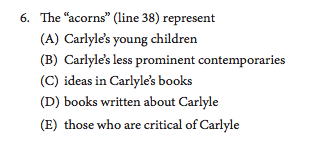
Type 6: Purpose of Part of the Text
Still other questions will ask you to identify what purpose a particular part of the text serves in the author's larger argument. What is the author trying to accomplish with the particular moment in the text identified in the question?
You can identify these questions because they will generally explicitly ask what purpose a certain part of the text serves. You may also see words or phrases like "serves to" or "function."

Type 7: Rhetorical Strategy
These questions will ask you to identify a rhetorical strategy used by the author. They will often specifically use the phrase "rhetorical strategy," although sometimes you will be able to identify them instead through the answer choices, which offer different rhetorical strategies as possibilities.
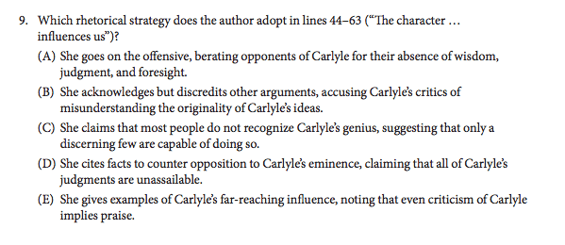
Type 8: Composition
This is the newest question type, first seen in the 2019/2020 school year. For these questions, the student will need to act as though they are the writer and think through different choices writers need to make when writing or revising text.
These questions can involve changing the order of sentences or paragraphs, adding or omitting information to strengthen an argument or improve clarity, making changes to draw reader attention, and other composition-based choices.

Some very important stylish effects going on here.
The AP English Language and Composition Free Response
The free response section has a 15-minute reading period. After that time, you will have 120 minutes to write three essays that address three distinct tasks.
Because the first essay involves reading sources, it is suggested that you use the entire 15-minute reading period to read the sources and plan the first essay. However, you may want to glance at the other questions during the reading period so that ideas can percolate in the back of your mind as you work on the first essay.
Essay One: Synthesis
For this essay, you will be briefly oriented on an issue and then given anywhere from six to seven sources that provide various perspectives and information on the issue. You will then need to write an argumentative essay with support from the documents.
If this sounds a lot like a DBQ , as on the history AP exams, that's because it is! However, this essay is much more argumentative in nature—your goal is to persuade, not merely interpret the documents.
Example (documents not included, see 2022 free response questions ):
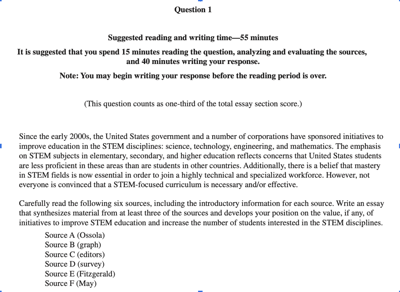
Essay Two: Rhetorical Analysis
In the second essay, you'll be presented with an excerpt from a nonfiction piece that advances an argument and asked to write an essay analyzing the rhetorical strategies used to construct the passage's argument. You will also be given some orienting information—where the passage was excerpted from, who wrote it, its approximate date, where it was published (if at all), and to whom it was directed.
Example (excerpt not included, see 2022 free response questions ):

Essay Three: Argument
In the third essay, you will be presented with an issue and asked to write a persuasive essay taking a position on the issue. You will need to support your position with evidence from your "reading, experience, and observations."
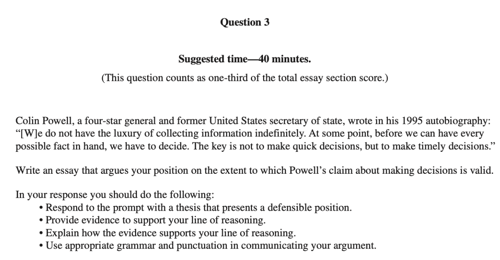
This doesn't look like a very well-constructed argument.
How The AP Language and Composition Exam Is Scored
The multiple-choice section of the exam is worth 45% of your score, and the free-response section is worth the other 55%. So each of the three free-response essays is worth about 18% of your score.
As on other APs, your raw score will be converted to a scaled score of 1-5. This exam has a relatively low 5 rate. Only 10% of test takers received a 5 in 2022 , although 56% of students received a score of 3 or higher.
In terms of how the raw score is obtained, the multiple-choice section is similar to other AP multiple-choice sections: you receive a point for every question you answer correctly, and there is no penalty for guessing.
The grading rubrics for the free-response questions were revamped in 2019. They are scored using analytic rubrics instead of holistic rubrics. For each free-response question, you will be given a score from 0-6. The rubrics assess three major areas:
#1: Thesis (0 to 1 points): Is there a thesis, and does it properly respond to the prompt?
#2: Evidence and Commentary (0 to 4 points): Does the essay include supporting evidence and analysis that is relevant, specific, well organized, and supports the thesis?
#3: Sophistication (0 to 1 points): Is the essay well-crafted and does it show a sufficiently nuanced understanding of the prompt?
Each scoring rubric broadly assesses these three factors. However, each task is also different in nature, so the rubrics do have some differences. I'll go over each rubric—and what it really means—for you here.
Synthesis Essay Rubrics
EVIDENCE AND COMMENTARY
SOPHISTICATION

Time to synthesize this dough into some cookies.
Rhetorical Analysis Essay Rubrics

Examine your texts closely!
Argumentative Essay Rubrics

The best kind of frenzy is a puppy frenzy!
AP English Language Prep Tips
Unlike its cousin, the AP English Literature and Composition exam, the AP Language and Composition exam (and course) have very little to do with fiction or poetry. So some students used to more traditional English classes may be somewhat at a loss as to what to do to prepare.
Luckily for you, I have a whole slate of preparation tips for you!
Read Nonfiction—In a Smart Way
A major thing you can do to prepare for the AP Lang and Comp exam is to read nonfiction— particularly nonfiction that argues a position , whether explicitly (like an op-ed) or implicitly (like many memoirs and personal essays). Read a variety of non-fiction genres and topics, and pay attention to the following:
- What is the author's argument?
- What evidence do they use to support their position?
- What rhetorical techniques and strategies do they use to build their argument?
- Are they persuasive? What counterarguments can you identify? Do they address them?
Thinking about these questions with all the reading you do will help you hone your rhetorical analysis skills.
Learn Rhetorical Terms and Strategies
Of course, if you're going to be analyzing the nonfiction works you read for their rhetorical techniques and strategies, you need to know what those are! You should learn a robust stable of rhetorical terms from your teacher, but here's my guide to the most important AP Language and Composition terms .
- We've compiled a list of 20 rhetorical devices you should know.
- A heroic individual from Riverside schools in Ohio uploaded this aggressively comprehensive list of rhetorical terms with examples. It's 27 pages long, and you definitely shouldn't expect to know all of these for the exam, but it's a useful resource for learning some new terms.
- Another great resource for learning about rhetorical analysis and how rhetorical devices are actually used is the YouTube Channel Teach Argument , which has videos rhetorically analyzing everything from Taylor Swift music videos to Super Bowl commercials. It's a fun way to think about rhetorical devices and get familiar with argumentative structures.
- Finally, a great book—which you might already use in your class—is " They Say, I Say. " This book provides an overview of rhetoric specifically for academic purposes, which will serve you well for AP preparation and beyond.
You also need to practice argumentative and persuasive writing. In particular, you should practice the writing styles that will be tested on the exam: synthesizing your own argument based on multiple outside sources, rhetorically analyzing another piece of writing in-depth, and creating a completely original argument based on your own evidence and experience.
You should be doing lots of writing assignments in your AP class to prepare, but thoughtful, additional writing will help. You don't necessarily need to turn all of the practice writing you do into polished pieces, either—just writing for yourself, while trying to address some of these tasks, will give you a low-pressure way to try out different rhetorical structures and argumentative moves, as well as practicing things like organization and developing your own writing style.

Not the most auspicious start to an argumentative essay.
Practice for the Exam
Finally, you'll need to practice specifically for the exam format. There are sample multiple-choice questions in the " AP Course and Exam Description ," and old free-response questions on the College Board website.
Unfortunately, the College Board hasn't officially released any complete exams from previous years for the AP English Language and Composition exam, but you might be able to find some that teachers have uploaded to school websites and so on by Googling "AP Language complete released exams." I also have a guide to AP Language and Composition practice tests .
Once you're prepped and ready to go, how can you do your best on the test?

AP Language and Composition Test Day Tips
Here are four key tips for test-day success.

You are one hundred percent success!
Interact With the Text
When you are reading passages, both on the multiple-choice section and for the first two free-response questions, interact with the text! Mark it up for things that seem important, devices you notice, the author's argument, and anything else that seems important to the rhetorical construction of the text. This will help you engage with the text and make it easier to answer questions or write an essay about the passage.
Think About Every Text's Overarching Purpose and Argument
Similarly, with every passage you read, consider the author's overarching purpose and argument. If you can confidently figure out what the author's primary assertion is, it will be easier to trace how all of the other aspects of the text play into the author's main point.
Plan Your Essays
The single most important thing you can do for yourself on the free-response section of the AP English Language exam is to spend a few minutes planning and outlining your essays before you start to write them.
Unlike on some other exams, where the content is the most important aspect of the essay, on the AP Language Exam, organization, a well-developed argument, and strong evidence are all critical to strong essay scores. An outline will help you with all of these things. You'll be able to make sure each part of your argument is logical, has sufficient evidence, and that your paragraphs are arranged in a way that is clear and flows well.
Anticipate and Address Counterarguments
Another thing you can do to give your free responses an extra boost is to identify counterarguments to your position and address them within your essay. This not only helps shore up your own position, but it's also a fairly sophisticated move in a timed essay that will win you kudos with AP graders.

Address counterarguments properly or they might get returned to sender!
Key Takeaways
The AP Language and Composition exam tests your rhetorical skills. The exam has two sections.
The first section is an hour-long, 45 question multiple-choice test based on the rhetorical techniques and composition choices.
The second section is a two-hour free-response section (with a 15-minute initial reading period) with three essay questions: one where you must synthesize given sources to make an original argument, one where you must rhetorically analyze a given passage, and one where you must create a wholly original argument about an issue with no outside sources given.
You'll receive one point for every correct answer on the multiple-choice section of the exam, which is worth 45% of your score. The free-response section is worth 55% of your score. For each free-response question, you'll get a score based on a rubric from 0-6. Your total raw score will be converted to a scaled score from 1-5.
Here are some test prep strategies for AP Lang:
#1 : Read nonfiction with an eye for rhetoric #2 : Learn rhetorical strategies and techniques #3 : Practice writing to deploy rhetorical skills #4 : Practice for the exam!
Here are some test-day success tips:
#1 : Interact with each passage you encounter! #2 : Consider every text's overarching purpose and argument. #3 : Keep track of time #4 : Plan your essays #5 : Identify and address counterarguments in your essays.
With all of this knowledge, you're ready to slay the AP English Language and Composition beast!

Noble knight, prepare to slay the AP dragon!
What's Next?
Want more AP Lang review? We have a complete collection of released AP Language practice tests , as well as a list of the AP Lang terms you need to know and a guide to the multiple choice section .
Taking the AP Literature exam? Check out our ultimate guide to the AP English Literature test and our list of AP Literature practice tests .
Taking other AP exams? See our Ultimate Guides to AP World History , AP US History , AP Chemistry , AP Biology , AP World History , and AP Human Geography .
Need more AP prep guidance? Check out how to study for AP exams and how to find AP practice tests .

These recommendations are based solely on our knowledge and experience. If you purchase an item through one of our links, PrepScholar may receive a commission.

Ellen has extensive education mentorship experience and is deeply committed to helping students succeed in all areas of life. She received a BA from Harvard in Folklore and Mythology and is currently pursuing graduate studies at Columbia University.
Student and Parent Forum
Our new student and parent forum, at ExpertHub.PrepScholar.com , allow you to interact with your peers and the PrepScholar staff. See how other students and parents are navigating high school, college, and the college admissions process. Ask questions; get answers.

Ask a Question Below
Have any questions about this article or other topics? Ask below and we'll reply!
Improve With Our Famous Guides
- For All Students
The 5 Strategies You Must Be Using to Improve 160+ SAT Points
How to Get a Perfect 1600, by a Perfect Scorer
Series: How to Get 800 on Each SAT Section:
Score 800 on SAT Math
Score 800 on SAT Reading
Score 800 on SAT Writing
Series: How to Get to 600 on Each SAT Section:
Score 600 on SAT Math
Score 600 on SAT Reading
Score 600 on SAT Writing
Free Complete Official SAT Practice Tests
What SAT Target Score Should You Be Aiming For?
15 Strategies to Improve Your SAT Essay
The 5 Strategies You Must Be Using to Improve 4+ ACT Points
How to Get a Perfect 36 ACT, by a Perfect Scorer
Series: How to Get 36 on Each ACT Section:
36 on ACT English
36 on ACT Math
36 on ACT Reading
36 on ACT Science
Series: How to Get to 24 on Each ACT Section:
24 on ACT English
24 on ACT Math
24 on ACT Reading
24 on ACT Science
What ACT target score should you be aiming for?
ACT Vocabulary You Must Know
ACT Writing: 15 Tips to Raise Your Essay Score
How to Get Into Harvard and the Ivy League
How to Get a Perfect 4.0 GPA
How to Write an Amazing College Essay
What Exactly Are Colleges Looking For?
Is the ACT easier than the SAT? A Comprehensive Guide
Should you retake your SAT or ACT?
When should you take the SAT or ACT?
Stay Informed
Get the latest articles and test prep tips!
Looking for Graduate School Test Prep?
Check out our top-rated graduate blogs here:
GRE Online Prep Blog
GMAT Online Prep Blog
TOEFL Online Prep Blog
Holly R. "I am absolutely overjoyed and cannot thank you enough for helping me!”
How to Write the AP Lang Argument Essay (With Example)
December 14, 2023

We’d like to let you in on a little secret: no one, including us, enjoys writing timed essays. But a little practice goes a long way. If you want to head into your AP English Exam with a cool head, you’ll want to know what you’re getting into ahead of time. We can’t promise the AP Lang Argument Essay will ever feel like an island vacation, but we do have tons of hand tips and tricks (plus a sample essay!) below to help you do your best. This article will cover: 1) What is the AP Lang Argumentative Essay? 2) AP Lang Argument Rubric 3) AP Lang Argument Sample Prompt 4) AP Lang Argument Essay Example 5) AP Lang Argument Essay Example: Answer Breakdown.
What is the AP Lang Argument Essay?
The AP Lang Argument Essay is one of three essays included in the written portion of the AP English Exam. The full AP English Exam is 3 hours and 15 minutes long, with the first 60 minutes dedicated to multiple-choice questions. Once you complete the multiple-choice section, you move on to three equally weighted essays that ask you to synthesize, analyze, and interpret texts and develop well-reasoned arguments. The three essays include:
Synthesis essay: You’ll review various pieces of evidence and then write an essay that synthesizes (aka combines and interprets) the evidence and presents a clear argument. Read our write-up on How to Write the AP Lang Synthesis Essay here.
Argumentative essay: You’ll take a stance on a specific topic and argue your case.
Rhetorical essay: You’ll read a provided passage, then analyze the author’s rhetorical choices and develop an argument that explains why the author made those rhetorical choices. Read our write-up on How to Write the AP Lang Rhetorical Essay here.
AP Lang Argument Essay Rubric
The AP Lang Argument Essay is graded on 3 rubric categories : Thesis, Evidence and Commentary, and Sophistication . How can you make sure you cover all three bases in your essay? We’ll break down each rubric category with dos and don’ts below:
- Thesis (0-1 point)
When it comes to grading your thesis, AP Exam graders are checking off a box: you either have a clear thesis or you don’t. So, what crucial components of a thesis will get you your check mark?
- Make sure your thesis argues something . To satisfy your graders, your thesis needs to take a clear stance on the issue at hand.
- Include your thesis statement in your intro paragraph. The AP Lang Argumentative essay is just that: an essay that makes an argument, so make sure you present your argument right away at the end of your first paragraph.
- A good test to see if you have a thesis that makes an argument for your AP Lang Argumentative Essay: In your head, add the phrase “I agree/disagree that…” to the beginning of your thesis. If what follows doesn’t logically flow after that phrase (aka if what follows isn’t an agreement or disagreement), it’s likely you’re not making an argument.
- In your thesis, outline the evidence you’ll cover in your body paragraphs.
AP Lang Argument Essay Rubric (Continued)
- Avoid a thesis that merely restates the prompt.
- Avoid a thesis that summarizes the text but does not make an argument.
- Avoid a thesis that weighs the pros and cons of an issue. Your job in your thesis is to pick a side and stick with it.
- Evidence and Commentary (0-4 points)
This rubric category is graded on a scale of 0-4 where 4 is the highest grade. Unlike the rhetorical and synthesis essays, the evidence you need to write your AP Lang Argument Essay is not provided to you. Rather, you’ll need to generate your own evidence and comment upon it.

What counts as evidence?
Typically, the AP Lang Argument Essay prompt asks you to reflect on a broad cultural, moral, or social issue that is open to debate. For evidence, you won’t be asked to memorize and cite statistics or facts. Rather, you’ll want to bring in real-world examples of:
- Historical events
- Current-day events from the news
- Personal anecdotes
For this essay, your graders know that you’re not able to do research to find the perfect evidence. What’s most important is that you find evidence that logically supports your argument.
What is commentary?
In this essay, it’s important to do more than just provide examples relevant evidence. After each piece of evidence you include, you’ll need to explain why it’s significant and how it connects to your main argument. The analysis you include after your evidence is commentary .
- Take a minute to brainstorm evidence that logically supports your argument. If you have to go out of your way to find the connection, it’s better to think of different evidence.
- Include multiple pieces of evidence. There is no magic number, but do make sure you incorporate more than a couple pieces of evidence that support your argument.
- Make sure you include more than one example of evidence, too. Let’s say you’re working on an essay that argues that people are always stronger together than apart. You’ve already included an example from history: during the civil rights era, protestors staged group sit-ins as a powerful form of peaceful protest. That’s just one example, and it’s hard to make a credible argument with just one piece of evidence. To fix that issue, think of additional examples from history, current events, or personal experience that are not related to the civil rights era.
- After you include each piece of evidence, explain why it’s significant and how it connects to your main argument.
- Don’t summarize or speak generally about the topic. Everything you write must be backed up with specific and relevant evidence and examples.
- Don’t let quotes speak for themselves. After every piece of evidence you include, make sure to explain and connect the evidence to your overarching argument.
AP Lang Argument Essay (Continued)
- Sophistication (0-1 point)
According to the College Board , one point can be awarded to AP Lang Argument essays that achieve a high level of sophistication. You can accomplish that in four ways:
- Crafting a nuanced argument by consistently identifying and exploring complexities or tensions.
- Articulating the implications or limitations of an argument by situating it within a broader context.
- Making effective rhetorical choices that consistently strengthen the force and impact of the student’s argument.
- Employing a style that is consistently vivid and persuasive.
In sum, this means you can earn an additional point for going above and beyond in depth, complexity of thought, or by writing an especially persuasive, clear, and well-structured essay. In order to earn this point, you’ll first need to do a good job with the fundamentals: your thesis, evidence, and commentary. Then, to earn your sophistication point, follow these tips:
- Outline your essay before you begin to ensure it flows in a clear and cohesive way.
- Include well-rounded evidence. Don’t rely entirely on personal anecdotes, for example. Incorporate examples from current events or history, as well.
- Thoroughly explain how each piece of evidence connects to your thesis in order to fully develop your argument.
- Explore broader implications. If what you’re arguing is true, what does that mean to us today? Who is impacted by this issue? What real-world issues are relevant to this core issue?
- Briefly explore the other side of the issue. Are the instances where your argument might not be true? Acknowledge the other side, then return to proving your original argument.
- Steer clear of generalizations (avoid words like “always” and “everyone”).
- Don’t choose an argument you can’t back up with relevant examples.
- Avoid complex sentences and fancy vocabulary words unless you use them often. Long, clunky sentences with imprecisely used words are hard to follow.
AP Lang Argument Sample Prompt
The sample prompt below is published online by the College Board and is a real example from the 2021 AP English Exam. The prompt provides background context, essay instructions, and the text you need to analyze.
Suggested time—40 minutes.
Many people spend long hours trying to achieve perfection in their personal or professional lives. Similarly, people often demand perfection from others, creating expectations that may be challenging to live up to. In contrast, some people think perfection is not attainable or desirable.
Write an essay that argues your position on the value of striving for perfection.
In your response you should do the following:
- Respond to the prompt with a thesis that presents a defensible position.
- Provide evidence to support your line of reasoning.
- Explain how the evidence supports your line of reasoning.
- Use appropriate grammar and punctuation in communicating your argument.
AP Lang Argument Essay Example
As the old phrase says, “Practice makes perfect.” But is perfection something that is actually attainable? Sometimes, pushing for perfection helps us achieve great things, but most often, perfectionism puts too much pressure on us and prevents us from knowing when we have done the best we can. Striving for perfection can only lead us to shortchange ourselves. Instead, we should value learning, growth, and creativity and not worry whether we are first or fifth best.
Students often feel the need to be perfect in their classes, and this can cause students to struggle or stop making an effort in class. In elementary and middle school, for example, I was very nervous about public speaking. When I had to give a speech, my voice would shake, and I would turn very red. My teachers always told me “relax!” and I got Bs on Cs on my speeches. As a result, I put more pressure on myself to do well, spending extra time making my speeches perfect and rehearsing late at night at home. But this pressure only made me more nervous, and I started getting stomach aches before speaking in public.
Once I got to high school, however, I started doing YouTube make-up tutorials with a friend. We made videos just for fun, and laughed when we made mistakes or said something silly. Only then, when I wasn’t striving to be perfect, did I get more comfortable with public speaking.
AP Lang Argumentative Essay Example (Continued)
In the world of art and business and science, perfectionism can also limit what we are able to achieve. Artists, for example, have to take risks and leave room for creativity. If artists strive for perfection, then they won’t be willing to fail at new experiments and their work will be less innovative and interesting. In business and science, many products, like penicillin for example, were discovered by accident. If the scientist who discovered penicillin mold growing on his petri dishes had gotten angry at his mistake and thrown the dishes away, he would never have discovered a medicine that is vital to us today.
Some fields do need to value perfection. We wouldn’t like it, for example, if our surgeon wasn’t striving for perfection during our operation. However, for most of us, perfectionism can limit our potential for learning and growth. Instead of trying to be perfect, we should strive to learn, innovate, and do our personal best.
AP Lang Argument Essay Example: Answer Breakdown
The sample AP Lang Argumentative Essay above has some strengths and some weaknesses. Overall, we would give this essay a 3 or a 4. Let’s break down what’s working and what could be improved:
- The essay offers a thesis that makes a clear argument that is relevant to the prompt: “Striving for perfection can only lead us to shortchange ourselves. Instead, we should value learning, growth, and creativity and not worry whether we are first or fifth best.”
- The first body paragraph provides evidence that supports the essay’s thesis. This student’s personal anecdote offers an example of a time when perfectionism led them to shortchange themselves.
- The second body paragraph provides additional evidence that supports the essay’s thesis. The example describing the discovery of penicillin offers another example of a situation in which perfectionism might have limited scientific progress.
- The writer offers commentary explaining how her examples of public speaking and penicillin illustrate that we should “value learning, growth, and creativity” over perfectionism.
- The essay follows one line of reasoning and does not stray into tangents.
- The essay is organized well with intro, body, and concluding paragraphs. Overall, it is easy to read and is free of grammar errors.
What could be improved:
- Although the second body paragraph provides one good specific example about the discovery of penicillin, the other examples it offers about art and business are only discussed generally and aren’t backed up with evidence. This paragraph would be stronger if it provided more examples. Or, if this writer couldn’t think of examples, they could have left out mentions of art and business altogether and included alternate evidence instead.
- This writer would more thoroughly support their argument if they were able to offer one more example of evidence. They could provide another personal anecdote, an example from history, or an example from current events.
- The writer briefly mentions the other side of the argument in their concluding paragraph: “Some fields do need to value perfection. We wouldn’t like it, for example, if our surgeon wasn’t striving for perfection during our operation.” Since it’s so brief a mention of the other side, it undermines the writer’s overall argument. This writer should either dedicate more time to reflecting on why even surgeons should “value learning, growth, and creativity” over perfectionism, or they should leave these sentences out.
AP Lang Argument Essay Example—More Resources
Looking for more tips to help you master your AP Lang Argumentative Essay? Brush up on 20 Rhetorical Devices High School Students Should Know and read our Tips for Improving Reading Comprehension .
If you’re ready to start studying for another part of the AP English Exam, find more expert tips in our How to Write the AP Lang Synthesis and How to Write the AP Lang Rhetorical Essay blog posts.
- High School Success

Christina Wood
Christina Wood holds a BA in Literature & Writing from UC San Diego, an MFA in Creative Writing from Washington University in St. Louis, and is currently a Doctoral Candidate in English at the University of Georgia, where she teaches creative writing and first-year composition courses. Christina has published fiction and nonfiction in numerous publications, including The Paris Review , McSweeney’s , Granta , Virginia Quarterly Review , The Sewanee Review , Mississippi Review , and Puerto del Sol , among others. Her story “The Astronaut” won the 2018 Shirley Jackson Award for short fiction and received a “Distinguished Stories” mention in the 2019 Best American Short Stories anthology.
- 2-Year Colleges
- Application Strategies
- Best Colleges by Major
- Best Colleges by State
- Big Picture
- Career & Personality Assessment
- College Essay
- College Search/Knowledge
- College Success
- Costs & Financial Aid
- Dental School Admissions
- Extracurricular Activities
- Graduate School Admissions
- High Schools
- Law School Admissions
- Medical School Admissions
- Navigating the Admissions Process
- Online Learning
- Private High School Spotlight
- Summer Program Spotlight
- Summer Programs
- Test Prep Provider Spotlight

“Innovative and invaluable…use this book as your college lifeline.”
— Lynn O'Shaughnessy
Nationally Recognized College Expert
College Planning in Your Inbox
Join our information-packed monthly newsletter.
I am a... Student Student Parent Counselor Educator Other First Name Last Name Email Address Zip Code Area of Interest Business Computer Science Engineering Fine/Performing Arts Humanities Mathematics STEM Pre-Med Psychology Social Studies/Sciences Submit
How To Use The New AP® English Scoring Rubric
Last summer, the major changes for the 2019-2020 school year across AP ® courses included a) new unit structures aligned to key course skills, b) teachers gained access to more resources through the launch of AP ® Classroom, and c) many exams underwent major changes. All of these changes were meant to better support AP ® students and teachers in their preparation for – and success on – the May AP ® exams.
Teachers of AP ® English Language and Composition and AP ® English Literature and Composition experienced one of the most significant changes: the introduction of a new analytic rubric for each exam’s Free Response Questions. This new rubric takes the place of the nine-point holistic rubric that has been in use for 20 years.
P.S. Based on feedback from teachers, the College Board made a few final tweaks to the rubrics, which they released on September 30, 2019 . Those changes helped clarify some parts of the rubric. They also released 10 scored student samples for each question of 2018 and 2019 with scoring commentaries!
Using the New AP ® English Rubric With Confidence
Such a significant change can be daunting. If you’ve felt less than prepared to use the new rubrics in your class, the good news is there are major benefits with the new approach.
We’ve been trying it out ourselves – scoring hundreds of previously released student samples alongside a team of expert College Board readers – and we believe the new rubric makes it easier to communicate and teach. That’s exciting news for teachers and students.
The analytic style of this rubric offers clearer direct measures of success. In each scoring category, there are technical requirements to meet, which makes expectations clearer for students and evaluation easier for teachers.
Plus, while development and analysis have always been critical to success on AP ® English work, this rubric offers a more visible focus on evidence and commentary – as well as clarification of exactly what this means.
“There are two aspects of the new rubric I liked most. The first is the analytical nature of the rubric. Since the categories are broken down into three distinct sections, it is easier to consider each portion of this score separately.
Second, i found the new rubric particularly thorough in its explanation. each reporting category clarified what types of responses would or would not earn a specific score for that category. the explanations were more focused and clearer for their descriptions.”, — michael stracco, ap ® english literature reader.
Being big fans of rubrics of all types, but especially analytic rubrics, Marco Learning is here to help. In this post, we break down the big changes and dig into the new rubrics that will be used to evaluate Free Response Questions starting with the May 2020 exams.
Here’s what we will cover in this post:
- Anatomy of the new rubric
- How to use the “decision rules” for scoring
- Implications for teaching
- How to share the new rubric with your students
Anatomy of the New Rubric
While essays were previously graded on a holistic scale of 0 to 9, reflecting overall quality, the College Board has switched to an analytic rubric, which evaluates student success out of 6 possible points across three scoring categories. The three scoring categories are:
- Thesis (1 point possible)
- Evidence and Commentary (4 points possible)
- Sophistication (1 point possible)

Linguistic change! If you’re familiar with the old rubric, you’ll notice a new word choice right away. The new rubric refers to commentary instead of analysis. We perceive this change to be more student friendly, in that it encompasses a broader range of student engagement with the text — rather than simply analyzing the technical aspects of the text/argument, students are encouraged to integrate commentary on important background elements of the text/argument!
Each of these “reporting categories” contains specific requirements that students must meet in order to earn points. The student’s identification and use of evidence continues to be weighted most heavily, with four of the six available points falling within the Evidence and Commentary reporting category.
Here are the core elements of the Synthesis Essay in AP ® English Language:
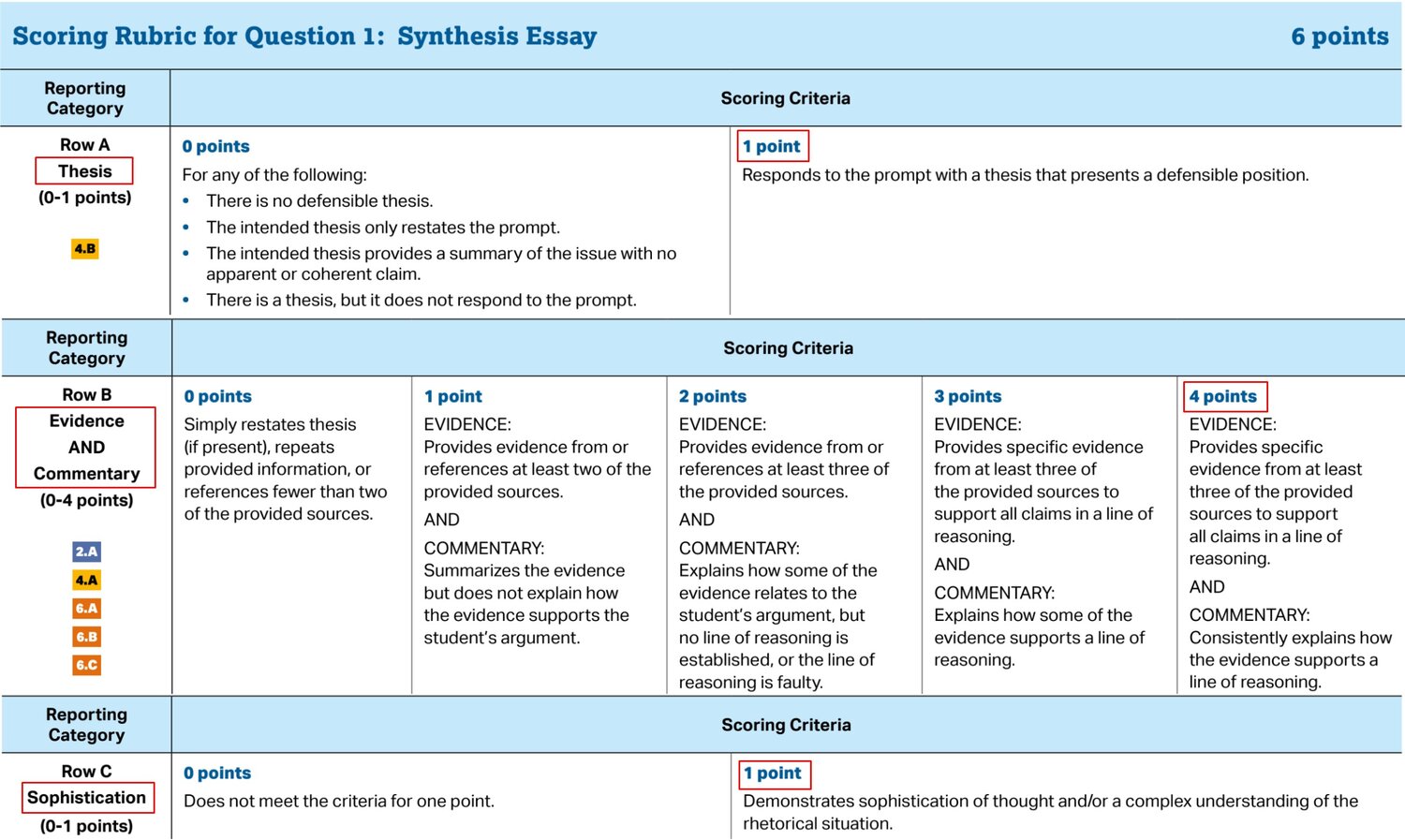
How do the rubrics vary by course and/or essay type?
- The scoring criteria for Thesis are nearly identical for all six essay types, with a slight modification for AP ® Literature to add that a student’s thesis must “present an interpretation” of the text in question.
- The Evidence and Commentary scoring criteria have slight variations to address the source of evidence that corresponds to each essay type.
- The Sophistication scoring criteria are identical across courses and all essay types.
Decision Rules for Scoring
In addition to the basic rubric scoring criteria, the College Board provides helpful “decision rules” for how to apply the criteria more specifically. Notably, these rules vary by essay type.
Access the complete College Board (and revised ) rubrics with the decision rules here:
AP ® English Language
- Q1: Synthesis Essay
- Q2: Rhetorical Analysis
- Q3: Argument Essay
AP ® English Literature
- Q1: Poetry Analysis
- Q2: Prose Fiction Analysis
- Q3: Literary Argument
Applying the Rubric to Student Samples
Many teachers will want to continue to use released exams for student practice (available on the College Board website: AP ® English Language , AP ® English Literature ).
Here’s how to apply the new rubric to your students’ practice timed writings.
Not only is the thesis a vital part of effective written work, it is now a scoring category for AP ® English essays – an explicit requirement. In each essay, students should “respond to the prompt with a thesis that presents a defensible position/interpretation” (the object here varies slightly depending on the question type). Understandably, this must take a position and should go beyond merely restating the prompt or summarizing source texts.
AP ® English Language Argument Essay: Thesis Category
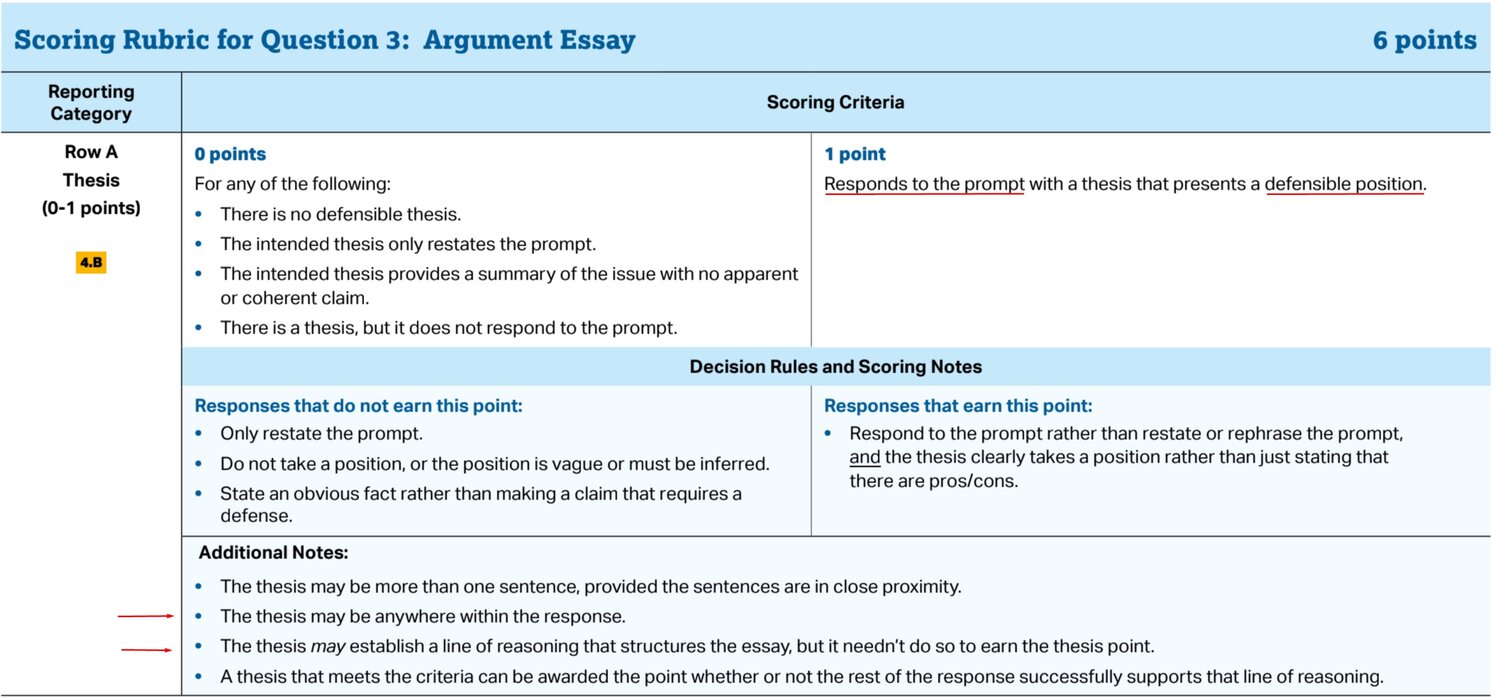
Pay special attention to the “additional notes” at the bottom:
First, a thesis located anywhere in the essay may earn the point. While it is typically not good practice for a student to bury their thesis in a conclusion paragraph (because the clarity of their argument may be impacted), a successful concluding thesis would earn the point. When the thesis is not obviously placed in its traditional spot at the end of an introductory paragraph, read closely in case a clear position in response to the prompt is hiding later in the essay.
Second, a thesis may earn a point even if the rest of the response does not support the same line of reasoning . The thesis is evaluated entirely independently from the successful development of the argument.
What changed about THESIS in the revised rubrics?
- Having a defensible position or interpretation (depending on essay type) matters, but the language around “establishing a line of reasoning” has been removed.
- Students are not expected to use the thesis to outline their essay. There have been a few scoring notes added, such as that the thesis does not necessarily need to be a single sentence, but the separate sentences need to be in close proximity.
B) EVIDENCE AND COMMENTARY
Worth 4 of the possible 6 points, the Evidence and Commentary category carries the weight of the new rubric. While the source of the evidence varies by essay type, regardless of prompt, students are asked to provide evidence for their position and expand on it with commentary that connects the evidence to their position.
Each rubric’s decision rules include descriptions of “typical” responses that fall into each score level. These descriptions will help you decide how to score a response, but may still prove challenging since you’ll still need to determine how successful a student’s explanation is and where that places it on the rubric.
AP ® English Language Argument Essay: Evidence and Commentary Category
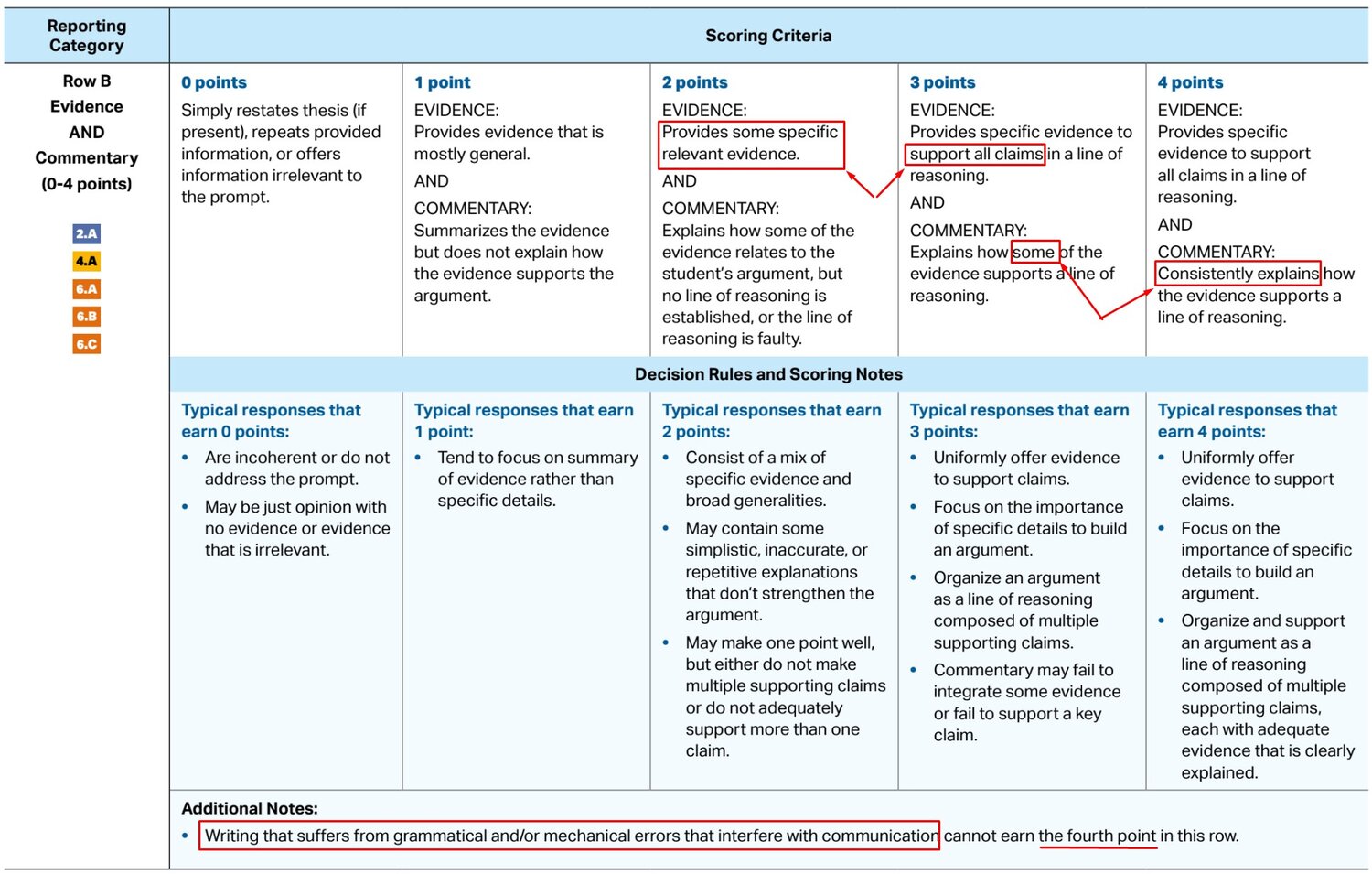
As our team of AP ® readers have practiced applying these rules, we have had the most difficulty determining what meets the level of “explanation” in the expectations of the AP ® Language Argument Essay rubric. If a student has provided explanation for their evidence, but not very successfully, for example, they may still be eligible for a score of 3 in this category. This might seem a bit high if you’re oriented to the rigor of the old holistic rubric, but as we’ll explain more below, you’ll need to move away from thinking in terms of the rigor of the old rubric or thinking of essays as “high” or “low.”
If you’re on the fence about a point, we recommend falling back to the classic guidance to reward students for what they do well , particularly in this scoring category. While that specific language has not persisted to this new rubric, based on what we know now, we expect it to persist as a value in College Board scoring on exams.
Note: An essay that does NOT earn the Thesis point is highly unlikely to earn 3 or 4 points in Evidence and Commentary. These higher scores require a clear connection between thesis and evidence.
What changed about EVIDENCE & COMMENTARY in the revised rubrics?
- Compared to the initial version, the College Board made a helpful structural change: Evidence and Commentary are now discussed independently within the scoring criteria.
- There is now more focus on supporting all claims for scores of 3 or 4 rather than simply providing examples or evidence that may not be totally successfully linked back to a claim.
C) SOPHISTICATION
We’ve found the Sophistication component requires the most group norming. There are 3-4 “ways” students might demonstrate sophistication of thought listed in the scoring notes, but the scoring criterion is king: the response must, above all, “demonstrate sophistication of thought and/or a complex understanding of the rhetorical situation.”
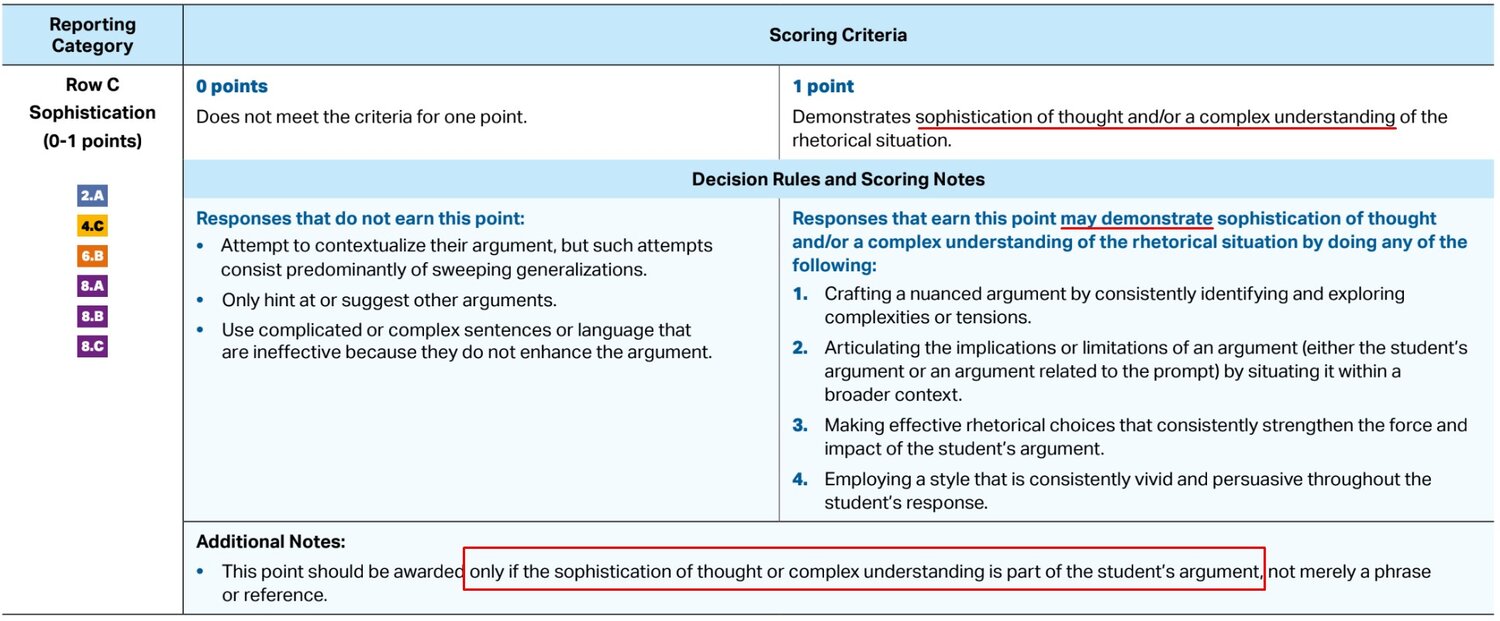
As noted in the rubric, sophistication must be part of the argument , not a passing phrase or reference. While it might be easy to coach students to fulfill one or more of the strategies (“check the box”), it will be very difficult for students to successfully earn the point.
What changed about SOPHISTICATION in the revised rubrics?
- The College Board has fine-tuned to the decision rules for this point. It is now more clear that this point is very rigorous.
- There are fewer examples of possible strategies (now 3-4 versus 5-6), notably removing “Utilizing a prose style that is appropriate to the student’s argument”.

Teacher tip: The ways a student might demonstrate sophistication may not be obvious for them to include in a response (e.g., using relevant analogies to help an audience better understand an interpretation or discussing alternative interpretations of a text). While we don’t recommend encouraging your students to incorporate the listed strategies to “check the box,” we do recommend encouraging them to be creative in their engagement with the text. And look to these descriptors for teaching ideas!
Avoid These Common Scoring Mistakes
Make sure your scoring is focused on the core areas of the AP ® rubric and doesn’t get caught up by any of these common scoring mistakes.
- Don’t focus on grammar and mechanics. These aspects of writing are relatively unimportant in scoring. However, if grammatical and/or mechanical errors are so frequent and significant that they interfere with your understanding of the essay, the student is ineligible for the fourth point in the Evidence and Commentary reporting category. It is, however, rare to see this level of technical writing errors in a high-scoring essay.
- Don’t penalize for “missing” conclusions. While they do make for “nicer” writing, conclusion paragraphs are usually brief and are not actually required in this exam! A student’s conclusion (or the lack of one) is not weighted in the score.
- Don’t be fooled by flowery writing! Sometimes, a student may write with sophisticated style or flowery language, but fail to adequately analyze evidence or support their argument. While these essays might sound nice, they don’t achieve the main goals of AP ® assignments — namely, the development and analysis of evidence in support of a relevant argument. If an essay is written extremely well on the surface, take a moment to consider whether it meets the assignment goals or if sophisticated styling is masking a lack of analysis. Make sure the specific scoring categories guide your evaluation of each student’s essay!
- Be careful not to compare the new analytic scoring with the old holistic scores. If you’re very familiar with the 9-point holistic rubric, you may be tempted to continue to consider essays in terms of their success on the old rubric, but the new analytic rubric requires a shift in thinking. Try not to compare the overall scores of students to each other (an overall score of 3 for two students might reflect success in different scoring categories, for example), and be careful about calibrating to past released student samples that were scored on the old scale.
“I believe that the main challenge with the new rubrics is developing a different mindset from the previous holistic scoring. The one for me that seemed most difficult to discard was seeing an essay as either an upper level or a lower level essay. The new rubric discourages such thinking, which many of us experienced scorers often relied upon when first reading through an essay.”

Implications for Teaching
We asked Michael Stracco, a long-time English teacher with sixteen years experience as a College Board reader for the AP ® Literature and Composition course, for his advice for teachers when guiding students on the new rubric.
What advice would you give to teachers when guiding students on the new rubric?
Any rubric is going to be a bit formulaic when it comes to preparing students. To the degree that the rubric describes good writing, this new rubric is clearly good teaching of writing. For example, the descriptors of a good thesis sentence are excellent. A teacher would do well to teach a student how to write a good, clear thesis which answers a prompt. However, in years past, it was conceivable that a thesis could be implied on these essays since a stated thesis was not a part of the rubric. Now it is a part of the rubric. Because of this change, all students must now be certain to have a clearly stated thesis. This is a bit formulaic, but it is what teachers must teach in order to prepare their students well for the test.
So this would be my advice to teachers:
- Remember that you are always a writing teacher. The aspects of writing a literary analysis response are still just teaching how to write well. To be specific, teach students to rely upon the text , to make an analysis of the text, and to elaborate upon that analysis. Be certain to teach students the difference between summary and analysis . This is the heart of scoring well in Row B.
- I would teach students to put the thesis in the introduction and to underline It always helps for a writer to think about audience in all writing, and in this case the audience is someone who is reading many essays and needs to be certain to see the thesis to assign the point.
- Regarding a thesis: Teach students that creating a good thesis has two purposes. The first is so that the reader knows where the piece is headed. But the second is so that the writer knows where the piece is headed.
- Related to this: Planning is essential before writing. You need to know your thesis so that you can keep the piece focused. As an experienced reader, I sometimes would see a student write him/herself into a good essay. The piece would develop into a better essay than the thesis. With a full point being for a good thesis, a student must plan before writing and must write within the context of the thesis or no point would be assigned.
Next Steps for Tackling the New Rubric
As you begin to use the new AP ® English rubrics in your classroom this school year, we encourage you to use the rubric categories and language to guide the skills you teach and follow these next steps:
- First, download our fillable Teacher English Language Scoring Rubric to keep track of all of these pointers when you are evaluating student work on the new AP ® English rubric. Make copies to reuse with each essay you grade!
TEACHER Scoring Rubric
- Second, plan a lesson to introduce your students to the new rubric. Review the rubric with them and prep them to use it for self-assessment on their next essay.
- Third, assign your first practice essay of the school year with confidence! Plan to have your class practice writing thesis statements, and give students plenty of opportunities to practice and workshop more straightforward evidence and commentary strategies.
If your school partners with Marco Learning, take advantage of the opportunity to get personalized feedback for your students from one of our qualified Graders. Graders complete qualification modules to demonstrate proficiency with the new rubric in addition to calibration exercises specific to each prompt.
Log in to your Marco Learning account , and pick from any College Board released prompts dating back to 1999. Scoring and feedback on all AP ® English prompts will be completed using the new rubrics so students and teachers can be prepared for the exams in May!
If we don’t currently work with your school, learn more about how Marco Learning supports AP teachers here .

Please read Marco Learning’s Terms and Conditions, click to agree, and submit to continue to your content.
Please read Marco Learning’s Terms and Conditions, click to agree, and submit at the bottom of the window.
MARCO LEARNING TERMS OF USE
Last Modified: 1/24/2023
Acceptance of the Terms of Use
These terms of use are entered into by and between You and Marco Learning LLC (“ Company “, “ we “, or “ us “). The following terms and conditions (these “ Terms of Use “), govern your access to and use of Marco Learning , including any content, functionality, and services offered on or through Marco Learning (the “ Website “), whether as a guest or a registered user.
Please read the Terms of Use carefully before you start to use the Website. By using the Website or by clicking to accept or agree to the Terms of Use when this option is made available to you, you accept and agree to be bound and abide by these Terms of Use. You may not order or obtain products or services from this website if you (i) do not agree to these Terms of Use, or (ii) are prohibited from accessing or using this Website or any of this Website’s contents, goods or services by applicable law . If you do not want to agree to these Terms of Use, you must not access or use the Website.
This Website is offered and available to users who are 13 years of age or older, and reside in the United States or any of its territories or possessions. Any user under the age of 18 must (a) review the Terms of Use with a parent or legal guardian to ensure the parent or legal guardian acknowledges and agrees to these Terms of Use, and (b) not access the Website if his or her parent or legal guardian does not agree to these Terms of Use. By using this Website, you represent and warrant that you meet all of the foregoing eligibility requirements. If you do not meet all of these requirements, you must not access or use the Website.
Changes to the Terms of Use
We may revise and update these Terms of Use from time to time in our sole discretion. All changes are effective immediately when we post them, and apply to all access to and use of the Website thereafter.
These Terms of Use are an integral part of the Website Terms of Use that apply generally to the use of our Website. Your continued use of the Website following the posting of revised Terms of Use means that you accept and agree to the changes. You are expected to check this page each time you access this Website so you are aware of any changes, as they are binding on you.
Accessing the Website and Account Security
We reserve the right to withdraw or amend this Website, and any service or material we provide on the Website, in our sole discretion without notice. We will not be liable if for any reason all or any part of the Website is unavailable at any time or for any period. From time to time, we may restrict access to some parts of the Website, or the entire Website, to users, including registered users.
You are responsible for (i) making all arrangements necessary for you to have access to the Website, and (ii) ensuring that all persons who access the Website through your internet connection are aware of these Terms of Use and comply with them.
To access the Website or some of the resources it offers, you may be asked to provide certain registration details or other information. It is a condition of your use of the Website that all the information you provide on the Website is correct, current, and complete. You agree that all information you provide to register with this Website or otherwise, including but not limited to through the use of any interactive features on the Website, is governed by our Marco Learning Privacy Policy , and you consent to all actions we take with respect to your information consistent with our Privacy Policy.
If you choose, or are provided with, a user name, password, or any other piece of information as part of our security procedures, you must treat such information as confidential, and you must not disclose it to any other person or entity. You also acknowledge that your account is personal to you and agree not to provide any other person with access to this Website or portions of it using your user name, password, or other security information. You agree to notify us immediately of any unauthorized access to or use of your user name or password or any other breach of security. You also agree to ensure that you exit from your account at the end of each session. You should use particular caution when accessing your account from a public or shared computer so that others are not able to view or record your password or other personal information.
We have the right to disable any user name, password, or other identifier, whether chosen by you or provided by us, at any time in our sole discretion for any or no reason, including if, in our opinion, you have violated any provision of these Terms of Use.
Intellectual Property Rights
The Website and its entire contents, features, and functionality (including but not limited to all information, software, text, displays, images, graphics, video, other visuals, and audio, and the design, selection, and arrangement thereof) are owned by the Company, its licensors, or other providers of such material and are protected by United States and international copyright, trademark, patent, trade secret, and other intellectual property or proprietary rights laws. Your use of the Website does not grant to you ownership of any content, software, code, date or materials you may access on the Website.
These Terms of Use permit you to use the Website for your personal, non-commercial use only. You must not reproduce, distribute, modify, create derivative works of, publicly display, publicly perform, republish, download, store, or transmit any of the material on our Website, except as follows:
- Your computer may temporarily store copies of such materials in RAM incidental to your accessing and viewing those materials.
- You may store files that are automatically cached by your Web browser for display enhancement purposes.
- You may print or download one copy of a reasonable number of pages of the Website for your own personal, non-commercial use and not for further reproduction, publication, or distribution.
- If we provide desktop, mobile, or other applications for download, you may download a single copy to your computer or mobile device solely for your own personal, non-commercial use, provided you agree to be bound by our end user license agreement for such applications.
- If we provide social media features with certain content, you may take such actions as are enabled by such features.
You must not:
- Modify copies of any materials from this site.
- Use any illustrations, photographs, video or audio sequences, or any graphics separately from the accompanying text.
- Delete or alter any copyright, trademark, or other proprietary rights notices from copies of materials from this site.
You must not access or use for any commercial purposes any part of the Website or any services or materials available through the Website.
If you wish to make any use of material on the Website other than that set out in this section, please contact us
If you print, copy, modify, download, or otherwise use or provide any other person with access to any part of the Website in breach of the Terms of Use, your right to use the Website will stop immediately and you must, at our option, return or destroy any copies of the materials you have made. No right, title, or interest in or to the Website or any content on the Website is transferred to you, and all rights not expressly granted are reserved by the Company. Any use of the Website not expressly permitted by these Terms of Use is a breach of these Terms of Use and may violate copyright, trademark, and other laws.
Trademarks, logos, service marks, trade names, and all related names, logos, product and service names, designs, and slogans are trademarks of the Company or its affiliates or licensors (collectively, the “ Trademarks ”). You must not use such Trademarks without the prior written permission of the Company. All other names, logos, product and service names, designs, and slogans on this Website are the trademarks of their respective owners.
Prohibited Uses
You may use the Website only for lawful purposes and in accordance with these Terms of Use. You agree not to use the Website:
- In any way that violates any applicable federal, state, local, or international law or regulation (including, without limitation, any laws regarding the export of data or software to and from the US or other countries).
- For the purpose of exploiting, harming, or attempting to exploit or harm minors in any way by exposing them to inappropriate content, asking for personally identifiable information, or otherwise.
- To send, knowingly receive, upload, download, use, or re-use any material that does not comply with the Content Standards set out in these Terms of Use.
- To transmit, or procure the sending of, any advertising or promotional material, including any “junk mail”, “chain letter”, “spam”, or any other similar solicitation.
- To impersonate or attempt to impersonate the Company, a Company employee, another user, or any other person or entity (including, without limitation, by using email addresses or screen names associated with any of the foregoing).
- To engage in any other conduct that restricts or inhibits anyone’s use or enjoyment of the Website, or which, as determined by us, may harm the Company or users of the Website or expose them to liability.
Additionally, you agree not to:
- Use the Website in any manner that could disable, overburden, damage, or impair the site or interfere with any other party’s use of the Website, including their ability to engage in real time activities through the Website.
- Use any robot, spider, or other automatic device, process, or means to access the Website for any purpose, including monitoring or copying any of the material on the Website.
- Use any manual process to monitor or copy any of the material on the Website or for any other unauthorized purpose without our prior written consent.
- Use any device, software, or routine that interferes with the proper working of the Website.
- Introduce any viruses, Trojan horses, worms, logic bombs, or other material that is malicious or technologically harmful.
- Attempt to gain unauthorized access to, interfere with, damage, or disrupt any parts of the Website, the server on which the Website is stored, or any server, computer, or database connected to the Website.
- Attack the Website via a denial-of-service attack or a distributed denial-of-service attack.
- Otherwise attempt to interfere with the proper working of the Website.
If you use, or assist another person in using the Website in any unauthorized way, you agree that you will pay us an additional $50 per hour for any time we spend to investigate and correct such use, plus any third party costs of investigation we incur (with a minimum $300 charge). You agree that we may charge any credit card number provided for your account for such amounts. You further agree that you will not dispute such a charge and that we retain the right to collect any additional actual costs.
User Contributions
The Website may contain message boards, chat rooms, personal web pages or profiles, forums, bulletin boards, and other interactive features (collectively, “ Interactive Services “) that allow users to post, submit, publish, display, or transmit to other users or other persons (hereinafter, “ post “) content or materials (collectively, “ User Contributions “) on or through the Website.
All User Contributions must comply with the Content Standards set out in these Terms of Use.
Any User Contribution you post to the site will be considered non-confidential and non-proprietary. By providing any User Contribution on the Website, you grant us and our affiliates and service providers, and each of their and our respective licensees, successors, and assigns the right to use, reproduce, modify, perform, display, distribute, and otherwise disclose to third parties any such material for any purpose.
You represent and warrant that:
- You own or control all rights in and to the User Contributions and have the right to grant the license granted above to us and our affiliates and service providers, and each of their and our respective licensees, successors, and assigns.
- All of your User Contributions do and will comply with these Terms of Use.
You understand and acknowledge that you are responsible for any User Contributions you submit or contribute, and you, not the Company, have full responsibility for such content, including its legality, reliability, accuracy, and appropriateness.
For any academic source materials such as textbooks and workbooks which you submit to us in connection with our online tutoring services, you represent and warrant that you are entitled to upload such materials under the “fair use” doctrine of copyright law. In addition, if you request that our system display a representation of a page or problem from a textbook or workbook, you represent and warrant that you are in proper legal possession of such textbook or workbook and that your instruction to our system to display a page or problem from your textbook or workbook is made for the sole purpose of facilitating your tutoring session, as “fair use” under copyright law.
You agree that we may record all or any part of any live online classes and tutoring sessions (including voice chat communications) for quality control and other purposes. You agree that we own all transcripts and recordings of such sessions and that these Terms of Use will be deemed an irrevocable assignment of rights in all such transcripts and recordings to us.
We are not responsible or liable to any third party for the content or accuracy of any User Contributions posted by you or any other user of the Website.
Monitoring and Enforcement: Termination
We have the right to:
- Remove or refuse to post any User Contributions for any or no reason in our sole discretion.
- Take any action with respect to any User Contribution that we deem necessary or appropriate in our sole discretion, including if we believe that such User Contribution violates the Terms of Use, including the Content Standards, infringes any intellectual property right or other right of any person or entity, threatens the personal safety of users of the Website or the public, or could create liability for the Company.
- Disclose your identity or other information about you to any third party who claims that material posted by you violates their rights, including their intellectual property rights or their right to privacy.
- Take appropriate legal action, including without limitation, referral to law enforcement, for any illegal or unauthorized use of the Website.
- Terminate or suspend your access to all or part of the Website for any or no reason, including without limitation, any violation of these Terms of Use.
Without limiting the foregoing, we have the right to cooperate fully with any law enforcement authorities or court order requesting or directing us to disclose the identity or other information of anyone posting any materials on or through the Website. YOU WAIVE AND HOLD HARMLESS THE COMPANY AND ITS AFFILIATES, LICENSEES, AND SERVICE PROVIDERS FROM ANY CLAIMS RESULTING FROM ANY ACTION TAKEN BY ANY OF THE FOREGOING PARTIES DURING, OR TAKEN AS A CONSEQUENCE OF, INVESTIGATIONS BY EITHER SUCH PARTIES OR LAW ENFORCEMENT AUTHORITIES.
However, we do not undertake to review material before it is posted on the Website, and cannot ensure prompt removal of objectionable material after it has been posted. Accordingly, we assume no liability for any action or inaction regarding transmissions, communications, or content provided by any user or third party. We have no liability or responsibility to anyone for performance or nonperformance of the activities described in this section.
Content Standards
These content standards apply to any and all User Contributions and use of Interactive Services. User Contributions must in their entirety comply with all applicable federal, state, local, and international laws and regulations. Without limiting the foregoing, User Contributions must not:
- Contain any material that is defamatory, obscene, indecent, abusive, offensive, harassing, violent, hateful, inflammatory, or otherwise objectionable.
- Promote sexually explicit or pornographic material, violence, or discrimination based on race, sex, religion, nationality, disability, sexual orientation, or age.
- Infringe any patent, trademark, trade secret, copyright, or other intellectual property or other rights of any other person.
- Violate the legal rights (including the rights of publicity and privacy) of others or contain any material that could give rise to any civil or criminal liability under applicable laws or regulations or that otherwise may be in conflict with these Terms of Use and our Privacy Policy .
- Be likely to deceive any person.
- Promote any illegal activity, or advocate, promote, or assist any unlawful act.
- Cause annoyance, inconvenience, or needless anxiety or be likely to upset, embarrass, alarm, or annoy any other person.
- Impersonate any person, or misrepresent your identity or affiliation with any person or organization.
- Involve commercial activities or sales, such as contests, sweepstakes, and other sales promotions, barter, or advertising.
- Give the impression that they emanate from or are endorsed by us or any other person or entity, if this is not the case.
(collectively, the “ Content Standards ”)
Copyright Infringement
If you believe that any User Contributions violate your copyright, please contact us and provide the following information:
- An electronic or physical signature of the person authorized to act on behalf of the owner of the copyright interest;
- A description of the copyrighted work that you claim has been infringed;
- A description of where the material you claim is infringing is located on the website (and such description must reasonably sufficient to enable us to find the alleged infringing material);
- Your address, telephone number and email address;
- A written statement by you that you have a good faith belief that the disputed use is not authorized by the copyright owner, its agent, or the law; and
- A statement by you, made under the penalty of perjury, that the above information in your notice is accurate and that you are the copyright owner or authorized to act on the copyright owner’s behalf.
We may terminate the accounts of any infringers.
Reliance on Information Posted
From time to time, we may make third party opinions, advice, statements, offers, or other third party information or content available on the Website or from tutors under tutoring services (collectively, “Third Party Content”). All Third Party Content is the responsibility of the respective authors thereof and should not necessarily be relied upon. Such third party authors are solely responsible for such content. WE DO NOT (I) GUARANTEE THE ACCURACY, COMPLETENESS OR USEFULNESS OF ANY THIRD PARTY CONTENT ON THE SITE OR ANY VERIFICATION SERVICES DONE ON OUR TUTORS OR INSTRUCTORS, OR (II) ADOPT, ENDORSE OR ACCEPT RESPONSIBILITY FOR THE ACCURACY OR RELIABILITY OF ANY OPINION, ADVICE, OR STATEMENT MADE BY ANY TUTOR OR INSTRUCTOR OR ANY PARTY THAT APPEARS ON THE WEBSITE. UNDER NO CIRCUMSTANCES WILL WE BE RESPONSBILE OR LIABLE FOR ANY LOSS OR DAMAGE RESULTING FROM YOUR RELIANCE ON INFORMATION OR OTHER CONENT POSTED ON OR AVAILBLE FROM THE WEBSITE.
Changes to the Website
We may update the content on this Website from time to time, but its content is not necessarily complete or up-to-date. Any of the material on the Website may be out of date at any given time, and we are under no obligation to update such material.
Information About You and Your Visits to the Website
All information we collect on this Website is subject to our Privacy Policy . By using the Website, you consent to all actions taken by us with respect to your information in compliance with the Privacy Policy.
Online Purchases and Other Terms and Conditions
All purchases through our site or other transactions for the sale of services and information formed through the Website or resulting from visits made by you are governed by our Terms of Sale, which are hereby incorporated into these Terms of Use.
Additional terms and conditions may also apply to specific portions, services, or features of the Website. All such additional terms and conditions are hereby incorporated by this reference into these Terms of Use.
Linking to the Website and Social Media Features
You may link to our homepage, provided you do so in a way that is fair and legal and does not damage our reputation or take advantage of it, but you must not establish a link in such a way as to suggest any form of association, approval, or endorsement on our part without our express written consent.
This Website may provide certain social media features that enable you to:
- Link from your own or certain third-party websites to certain content on this Website.
- Send emails or other communications with certain content, or links to certain content, on this Website.
- Cause limited portions of content on this Website to be displayed or appear to be displayed on your own or certain third-party websites.
You may use these features solely as they are provided by us, and solely with respect to the content they are displayed with and otherwise in accordance with any additional terms and conditions we provide with respect to such features. Subject to the foregoing, you must not:
- Establish a link from any website that is not owned by you.
- Cause the Website or portions of it to be displayed on, or appear to be displayed by, any other site, for example, framing, deep linking, or in-line linking.
- Link to any part of the Website other than the homepage.
- Otherwise take any action with respect to the materials on this Website that is inconsistent with any other provision of these Terms of Use.
The website from which you are linking, or on which you make certain content accessible, must comply in all respects with the Content Standards set out in these Terms of Use.
You agree to cooperate with us in causing any unauthorized framing or linking immediately to stop. We reserve the right to withdraw linking permission without notice.
We may disable all or any social media features and any links at any time without notice in our discretion.
Links from the Website
If the Website contains links to other sites and resources provided by third parties (“ Linked Sites ”), these links are provided for your convenience only. This includes links contained in advertisements, including banner advertisements and sponsored links. You acknowledge and agree that we have no control over the contents, products, services, advertising or other materials which may be provided by or through those Linked sites or resources, and accept no responsibility for them or for any loss or damage that may arise from your use of them. If you decide to access any of the third-party websites linked to this Website, you do so entirely at your own risk and subject to the terms and conditions of use for such websites.
You agree that if you include a link from any other website to the Website, such link will open in a new browser window and will link to the full version of an HTML formatted page of this Website. You are not permitted to link directly to any image hosted on the Website or our products or services, such as using an “in-line” linking method to cause the image hosted by us to be displayed on another website. You agree not to download or use images hosted on this Website or another website, for any purpose, including, without limitation, posting such images on another website. You agree not to link from any other website to this Website in any manner such that the Website, or any page of the Website, is “framed,” surrounded or obfuscated by any third party content, materials or branding. We reserve all of our rights under the law to insist that any link to the Website be discontinued, and to revoke your right to link to the Website from any other website at any time upon written notice to you.
Geographic Restrictions
The owner of the Website is based in the state of New Jersey in the United States. We provide this Website for use only by persons located in the United States. We make no claims that the Website or any of its content is accessible or appropriate outside of the United States. Access to the Website may not be legal by certain persons or in certain countries. If you access the Website from outside the United States, you do so on your own initiative and are responsible for compliance with local laws.
Disclaimer of Warranties
You understand that we cannot and do not guarantee or warrant that files available for downloading from the internet or the Website will be free of viruses or other destructive code. You are responsible for implementing sufficient procedures and checkpoints to satisfy your particular requirements for anti-virus protection and accuracy of data input and output, and for maintaining a means external to our site for any reconstruction of any lost data. TO THE FULLEST EXTENT PROVIDED BY LAW, WE WILL NOT BE LIABLE FOR ANY LOSS OR DAMAGE CAUSED BY A DISTRIBUTED DENIAL-OF-SERVICE ATTACK, VIRUSES, OR OTHER TECHNOLOGICALLY HARMFUL MATERIAL THAT MAY INFECT YOUR COMPUTER EQUIPMENT, COMPUTER PROGRAMS, DATA, OR OTHER PROPRIETARY MATERIAL DUE TO YOUR USE OF THE WEBSITE OR ANY SERVICES OR ITEMS OBTAINED THROUGH THE WEBSITE OR TO YOUR DOWNLOADING OF ANY MATERIAL POSTED ON IT, OR ON ANY WEBSITE LINKED TO IT.
YOUR USE OF THE WEBSITE, ITS CONTENT, AND ANY SERVICES OR ITEMS OBTAINED THROUGH THE WEBSITE IS AT YOUR OWN RISK. THE WEBSITE, ITS CONTENT, AND ANY SERVICES OR ITEMS OBTAINED THROUGH THE WEBSITE ARE PROVIDED ON AN “AS IS” AND “AS AVAILABLE” BASIS, WITHOUT ANY WARRANTIES OF ANY KIND, EITHER EXPRESS OR IMPLIED. NEITHER THE COMPANY NOR ANY PERSON ASSOCIATED WITH THE COMPANY MAKES ANY WARRANTY OR REPRESENTATION WITH RESPECT TO THE COMPLETENESS, SECURITY, RELIABILITY, QUALITY, ACCURACY, OR AVAILABILITY OF THE WEBSITE. WITHOUT LIMITING THE FOREGOING, NEITHER THE COMPANY NOR ANYONE ASSOCIATED WITH THE COMPANY REPRESENTS OR WARRANTS THAT THE WEBSITE, ITS CONTENT, OR ANY SERVICES OR ITEMS OBTAINED THROUGH THE WEBSITE WILL BE ACCURATE, RELIABLE, ERROR-FREE, OR UNINTERRUPTED, THAT DEFECTS WILL BE CORRECTED, THAT OUR SITE OR THE SERVER THAT MAKES IT AVAILABLE ARE FREE OF VIRUSES OR OTHER HARMFUL COMPONENTS, OR THAT THE WEBSITE OR ANY SERVICES OR ITEMS OBTAINED THROUGH THE WEBSITE WILL OTHERWISE MEET YOUR NEEDS OR EXPECTATIONS.
TO THE FULLEST EXTENT PROVIDED BY LAW, THE COMPANY HEREBY DISCLAIMS ALL WARRANTIES OF ANY KIND, WHETHER EXPRESS OR IMPLIED, STATUTORY, OR OTHERWISE, INCLUDING BUT NOT LIMITED TO ANY WARRANTIES OF MERCHANTABILITY, NON-INFRINGEMENT, AND FITNESS FOR PARTICULAR PURPOSE.
THE FOREGOING DOES NOT AFFECT ANY WARRANTIES THAT CANNOT BE EXCLUDED OR LIMITED UNDER APPLICABLE LAW.
Limitation on Liability
TO THE FULLEST EXTENT PROVIDED BY LAW, IN NO EVENT WILL THE COMPANY, ITS AFFILIATES, OR THEIR LICENSORS, SERVICE PROVIDERS, EMPLOYEES, AGENTS, OFFICERS, OR DIRECTORS BE LIABLE FOR DAMAGES OF ANY KIND, UNDER ANY LEGAL THEORY, ARISING OUT OF OR IN CONNECTION WITH YOUR USE, OR INABILITY TO USE, THE WEBSITE, ANY WEBSITES LINKED TO IT, ANY CONTENT ON THE WEBSITE OR SUCH OTHER WEBSITES, INCLUDING ANY DIRECT, INDIRECT, SPECIAL, INCIDENTAL, CONSEQUENTIAL, OR PUNITIVE DAMAGES, INCLUDING BUT NOT LIMITED TO, PERSONAL INJURY, PAIN AND SUFFERING, EMOTIONAL DISTRESS, LOSS OF REVENUE, LOSS OF PROFITS, LOSS OF BUSINESS OR ANTICIPATED SAVINGS, LOSS OF USE, LOSS OF GOODWILL, LOSS OF DATA, AND WHETHER CAUSED BY TORT (INCLUDING NEGLIGENCE), BREACH OF CONTRACT, OR OTHERWISE, EVEN IF FORESEEABLE.
THE FOREGOING DOES NOT AFFECT ANY LIABILITY THAT CANNOT BE EXCLUDED OR LIMITED UNDER APPLICABLE LAW.
Indemnification
You agree to defend, indemnify, and hold harmless the Company, its affiliates, licensors, and service providers, and its and their respective officers, directors, employees, contractors, agents, licensors, suppliers, successors, and assigns from and against any claims, liabilities, damages, judgments, awards, losses, costs, expenses, or fees (including reasonable attorneys’ fees) arising out of or relating to your violation of these Terms of Use or your use of the Website, including, but not limited to, your User Contributions, any use of the Website’s content, services, and products other than as expressly authorized in these Terms of Use or your use of any information obtained from the Website.
Governing Law and Jurisdiction
All matters relating to the Website and these Terms of Use and any dispute or claim arising therefrom or related thereto (in each case, including non-contractual disputes or claims), shall be governed by and construed in accordance with the internal laws of the State of New Jersey without giving effect to any choice or conflict of law provision or rule (whether of the State of New Jersey or any other jurisdiction).
Any legal suit, action, or proceeding arising out of, or related to, these Terms of Use or the Website shall be instituted exclusively in the federal courts of the United States or the courts of the State of New Jersey in each case located in the County of Monmouth although we retain the right to bring any suit, action, or proceeding against you for breach of these Terms of Use in your country of residence or any other relevant country. You waive any and all objections to the exercise of jurisdiction over you by such courts and to venue in such courts. You may not under any circumstances commence or maintain against us any class action, class arbitration, or other representative action or proceeding.
Arbitration
By using this Website, you agree, at Company’s sole discretion, that it may require you to submit any disputes arising from the use of these Terms of Use or the Website, including disputes arising from or concerning their interpretation, violation, invalidity, non-performance, or termination, to final and binding arbitration under the Rules of Arbitration of the American Arbitration Association applying New Jersey law. In doing so, YOU GIVE UP YOUR RIGHT TO GO TO COURT to assert or defend any claims between you and us. YOU ALSO GIVE UP YOUR RIGHT TO PARTICIPATE IN A CLASS ACTION OR OTHER CLASS PROCEEDING. Your rights may be determined by a NEUTRAL ARBITRATOR, NOT A JUDGE OR JURY. You are entitled to a fair hearing before the arbitrator. The arbitrator can grant any relief that a court can, but you should note that arbitration proceedings are usually simpler and more streamlined than trials and other judicial proceedings. Decisions by the arbitrator are enforceable in court and may be overturned by a court only for very limited reasons.
Any proceeding to enforce this arbitration provision, including any proceeding to confirm, modify, or vacate an arbitration award, may be commenced in any court of competent jurisdiction. In the event that this arbitration provision is for any reason held to be unenforceable, any litigation against Company must be commenced only in the federal or state courts located in Monmouth County, New Jersey. You hereby irrevocably consent to the jurisdiction of those courts for such purposes.
Limitation on Time to File Claims
ANY CAUSE OF ACTION OR CLAIM YOU MAY HAVE ARISING OUT OF OR RELATING TO THESE TERMS OF USE OR THE WEBSITE MUST BE COMMENCED WITHIN ONE (1) YEAR AFTER THE CAUSE OF ACTION ACCRUES, OTHERWISE, SUCH CAUSE OF ACTION OR CLAIM IS PERMANENTLY BARRED.
Waiver and Severability
No waiver by the Company of any term or condition set out in these Terms of Use shall be deemed a further or continuing waiver of such term or condition or a waiver of any other term or condition, and any failure of the Company to assert a right or provision under these Terms of Use shall not constitute a waiver of such right or provision.
If any provision of these Terms of Use is held by a court or other tribunal of competent jurisdiction to be invalid, illegal, or unenforceable for any reason, such provision shall be eliminated or limited to the minimum extent such that the remaining provisions of the Terms of Use will continue in full force and effect.
Entire Agreement
The Terms of Use, our Privacy Policy, and Terms of Sale constitute the sole and entire agreement between you and Marco Learning LLC regarding the Website and supersede all prior and contemporaneous understandings, agreements, representations, and warranties, both written and oral, regarding the Website.
Communications and Miscellaneous
If you provide us your email address, you agree and consent to receive email messages from us. These emails may be transaction or relationship communications relating to the products or services we offer, such as administrative notices and service announcements or changes, or emails containing commercial offers, promotions or special offers from us.
Your Comments and Concerns
This website is operated by Marco Learning LLC, a New Jersey limited liability company with an address of 113 Monmouth Road, Suite 1, Wrightstown, New Jersey 08562.
Please contact us for all other feedback, comments, requests for technical support, and other communications relating to the Website.

AP® English Language
Understanding the ap® english language argument rubric.
- The Albert Team
- Last Updated On: March 1, 2022
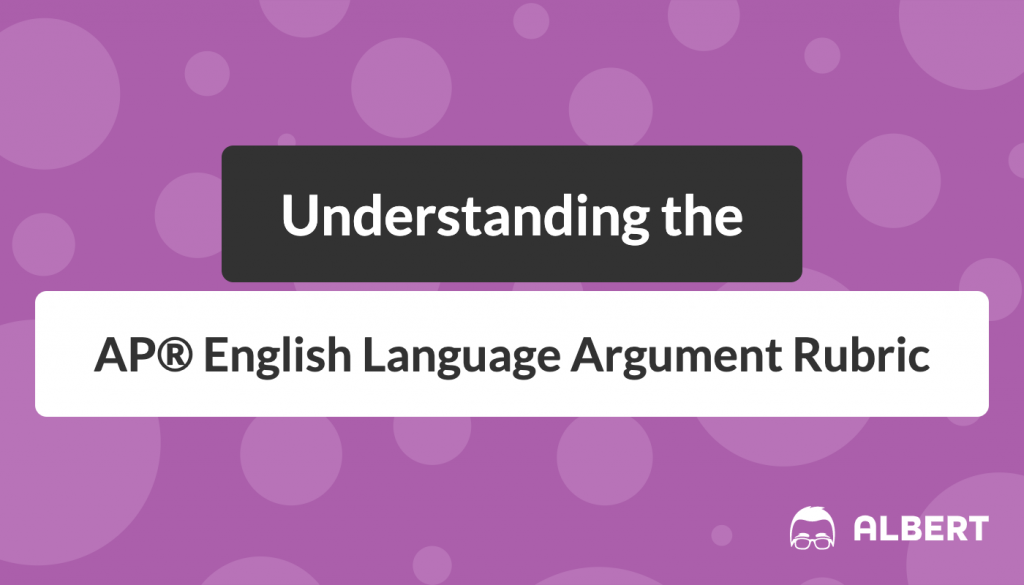
The AP® English Language exam contains three essays, two of which are the argument essays. The argument essays come with a prompt that contains a passage. The student must then analyze and immediately craft an appropriate argument that answers the prompt. This essay is different than the synthesis essay in that there is only one prompt that the student must analyze; however, the passage is much longer than the smaller sources found in the synthesis essay. In order to succeed on the AP® English Language argument essay the student must support his or her argument proficiently. This can be done by referencing the passage, adding his or her experiences, utilizing logic, and maintaining readable grammar and mechanics.
It is important, however, to note that the examiners know that you only have two hours and fifteen minutes to write three essays. Because of this, the essays do not have to be pristine, but they need to be firm in their argument, and more importantly, well-developed.
Referencing the Passage
You are given a passage and a prompt at the start of the argument essay that you as the writer must adhere to. Do not attempt to go off-topic, because the highest score that an off-topic argument essay can earn on the rubric is a 1. This argument must be supported as you write, and one of the best ways to do this is to reference the passage that you are given. This passage is your concrete proof for your argument, so utilize it. It is one of your greatest tools. An argument essay that has support from its passage allows the student to show that they can utilize sophisticated methods of supporting their arguments.
An example of a student that argues well to support his or her claim is seen below. The student is arguing that college is worth the money.
The largest motivator behind going or not going to college seems to be money. It is commonly accepted that a college education results in better financial situations later in life. It is certainly true that college grads earn, on average, 20,000 dollars more per year than those with only a high school diploma. (source F). It is also true that college grads are less likely to be unemployed. (source D)
This argument is done so well, because he or she references the text and analyzes it. By doing so, the student gains further depth to the argument and this student’s full essay (1A) would receive a score of an 8.
An example of an argument that does not reference the text is the following:
Primarily, a college education is worth the cost because you will never find yourself working in a fast food restaurant such as McDonald’s or Burger King. However, many people do not have a choice to work at fast food restaurants because they can’t afford college and their parents can’t afford it.
This argument, while developed, is not as convincing as the student that references the text correctly and clearly. Because of this, this student’s full essay (1C) would receive a lower score of 4.
Knowledge or Personal Experiences
Unlike the synthesis essay, the argument essays allow the student to insert any relevant knowledge or personal experiences that he or she has. This serves the purpose of bringing even more depth to the argument, and allows the student to show what they know.
The key to adding knowledge, and especially personal experience, is to only use relevant details. The College Board does not need to know about how fun your trip to the beach was, but if a small part of the experience relates to the prompt, then use it. Relating your argument to a relevant event can show the examiners that you can apply a concept, which may bump your score up a point.
An example of knowledge used in an AP® English Language argumentative essay is Student 1A that was referenced above. Student 1A does a great job implementing his or her knowledge by saying the following:
Coincidentally personal growth also plays a large role in the perceived quality of life. Taking this into consideration makes college more than a machine designed to increase an individual’s level of monetary success.
This student is using his or her knowledge here, showing how it is not only money that affects someone later in life, but the experiences that the person has in college. This is effective, showing why he or she received an 8.
Utilizing Logic and Details
Supporting details and logical arguments are a key point in the AP® English Language argument essay rubric , because lending more support to your argument allows the examiners to buy into that argument. When the examiners see your point so nicely developed, then you will jump up to higher scores such as 7s, 8s, or 9s depending on how much support there is and your eloquence.
Student 1A is an example of utilizing logic to support his or her argument. The student says the following:
Putting aside the idea of money seems counterintuitive when considering the worth of an education, but it is necessary. There is more to life. A large part of college is also personal growth.
This appeal to logic is used as a transition as the student brings a realistic approach to the prompt. The examiners will see this as a masterful use of adding details to the argument without losing track of the argument itself. Also, the examiners see that the student can stand on his own without the sources, although he or she utilizes them later on.
A student that does not utilize logic well is Student 1B . This student is heavily dependent on quotations from the sources, and this causes the student’s credibility to falter. The reader questions if the student is able to form his or her own ideas in a logical manner, leading to a drop in the student’s score. Being unable to form a logical structure to lay your argument on will result in a lower score of a 4 or a 5.
Use of Language
The use of language, while not the most influential part of the essay, does have an effect on the overall score. By use of language we mean the degree that the student utilizes grammar, spelling, and mechanics as well as figurative language that adds a persuasive element.
If the student uses the language well, then this will reveal to the examiner that the student can use writing as a tool to persuade. This is important in the AP® English Language argument essay, because inserting parallel structure or a perfectly placed analogy will impress your examiner.
Your grammar may not be the most pressing matter in the argument essay; however, if your grammar or mechanics are so poor that you are unclear in your argument, then the highest score that you can receive on the AP® English Language argument essay rubric is a 2.
Key Takeaways from the AP® English Language Argument Essay Rubric
In order to cover all of your bases in the AP® English Language exam argument essay you will want to be sure to practice months before the exam. Preparation is everything. A useful tip is to have the AP® English Language argument rubric in front of you as you write your first few attempts at a practice essay. This will keep your argument essay focused.
The most important part of the argument essay is to support your thesis, or the claim that you make to fulfill the prompt. If you reference the passage that you are given, add your own knowledge or personal experiences, be as detailed and logical as possible, and utilize language well, then your score will rise toward that sought-after 9.
Photo by Jeff Billings [CC BY-SA 3.0 (http://creativecommons.org/licenses/by-sa/3.0)], via Wikimedia Commons
By the way, you should check out Albert.io for your AP® English Language review. We have hundreds of AP® English Language practice questions written just for you!
Interested in a school license?
Popular posts.

AP® Score Calculators
Simulate how different MCQ and FRQ scores translate into AP® scores

AP® Review Guides
The ultimate review guides for AP® subjects to help you plan and structure your prep.

Core Subject Review Guides
Review the most important topics in Physics and Algebra 1 .

SAT® Score Calculator
See how scores on each section impacts your overall SAT® score

ACT® Score Calculator
See how scores on each section impacts your overall ACT® score

Grammar Review Hub
Comprehensive review of grammar skills

AP® Posters
Download updated posters summarizing the main topics and structure for each AP® exam.
Interested in a school license?

Bring Albert to your school and empower all teachers with the world's best question bank for: ➜ SAT® & ACT® ➜ AP® ➜ ELA, Math, Science, & Social Studies aligned to state standards ➜ State assessments Options for teachers, schools, and districts.

IMAGES
VIDEO
COMMENTS
AP® English Language Scoring Rubrics Free-Response Question 1: Synthesis Essay Free-Response Question 2: Rhetorical Analysis ... Scoring Rubric for Question 1: Synthesis Essay 6 points Reporting Category Scoring Criteria Row A Thesis (0-1 points) 4.B 0 points For any of the following: • There is no defensible thesis. • The intended thesis ...
Since the AP Language Exam is a standardized test, there are specific things readers are looking for to award points in each category, which are outlined in the rubric for the essay questions. Thesis (0-1 point) According to the AP Language rubric, your thesis must respond to the prompt with a thesis that presents a defensible position.
® and AP are trademarks registered b the ollege oard, which is not affiliated with, and does not endorse, this product ... AP ® English Language and Composition. Scoring Rubric for Question 1: Synthesis Essay. 0 POINTS. 1 POINT: For any of the following: No defensible thesis Simple restatement of prompt only Summary of topic with no clear claim
AP English Language and Composition Question 1: Synthesis (2019) Sample Student Responses 1 The student responses in this packet were selected from the 2019 Reading and have been rescored using the new rubrics for 2020. Commentaries for each sample are provided in a separate document. Student responses have been transcribed verbatim; any errors ...
AP English Language and Composition Question 3: Argument (2019) Sample Student Responses 1 The student responses in this packet were selected from the 2019 Reading and have been rescored using the new rubrics for 2020. Commentaries for each sample are provided in a separate document.
The first part of the exam is a multiple choice section. The questions ask students to analyze nonfiction texts (23-25 questions) and make editing choices on short essays (20-22 questions). The multiple choice section accounts for 45% of the AP Language exam score, and students are given one hour to complete it.
Format of the 2024 AP English Language and Composition exam. This year, all AP exams will cover all units and essay types. The 2024 AP English Language and Composition exam format will be: Section I: Multiple Choice - 45% of your score. 45 questions in 1 hour. Section II: Free Response Section - 55% of your score. 2 hours and 15 minutes for:
The AP English Language and Composition Multiple-Choice. The multiple-choice section tests you on two main areas. The first is how well you can read and understand nonfiction passages for their use of rhetorical devices and tools. The second is how well you can "think like a writer" and make revisions to texts in composition questions.
Complicated/complex sentences, or language is ineffective Nuanced thesis that is supported throughout the argument Acknowledgement of limitations and implications of an argument (by the student or included in the sources) that examines the broader context Successful rhetorical choices by the student SOPHISTICATION Mature and consistent writing ...
Microsoft Word - ap_writing_rubric[1].doc. AP English Language and Composition 9-point Rubric. 9. Essays earning a score of 9 meet the criteria for 8 papers and, in addition, are especially full or apt. in their analysis or demonstrate particularly impressive control of language. 8. Essays earning a score of 8 effectively respond to the prompt.
AP English Language and Composition Scoring Rubrics (Effective Fall 2019) September 2019 . Scoring Rubric for Question 2: Rhetorical Analysis (6 points) Reporting Category Scoring Criteria . Row A Thesis (0-1 points)
AP ® English Language and Composition ... Stronger essays used commentary to explain how the evidence supported the larger claim. Sample: 3A Score: 1-4-1 Thesis (0-1) points: 1 . The thesis, which is stated at the end of paragraph 1, takes a nuanced position on the value of striving for
Her story "The Astronaut" won the 2018 Shirley Jackson Award for short fiction and received a "Distinguished Stories" mention in the 2019 Best American Short Stories anthology. Ap Lang Argumentative Essay - Expert advice on how to pen a winning essay + an AP Lang argument essay example to guide your writing.
First, download our fillable Teacher English Language Scoring Rubric to keep track of all of these pointers when you are evaluating student work on the new AP ® English rubric. Make copies to reuse with each essay you grade! TEACHER Scoring Rubric. Second, plan a lesson to introduce your students to the new rubric.
Utilizing Logic and Details. Supporting details and logical arguments are a key point in the AP® English Language argument essay rubric, because lending more support to your argument allows the examiners to buy into that argument. When the examiners see your point so nicely developed, then you will jump up to higher scores such as 7s, 8s, or ...